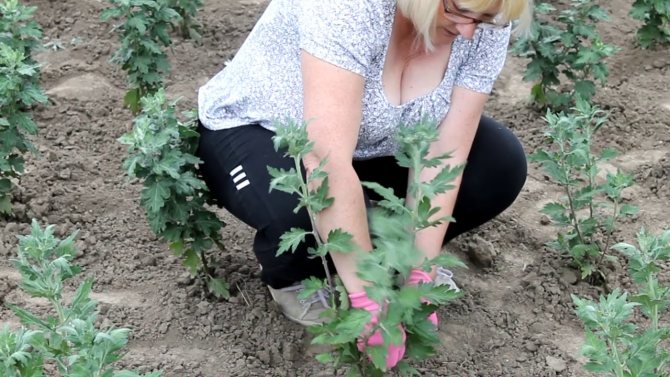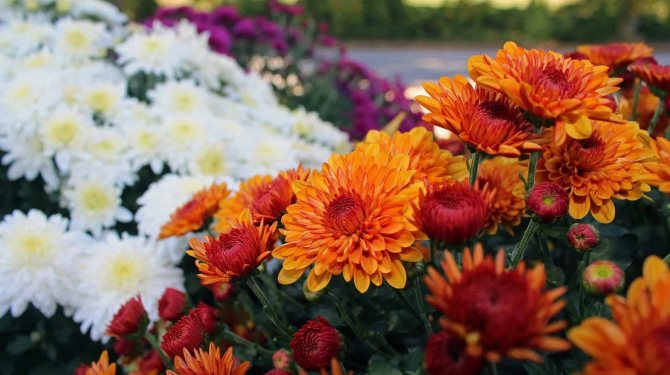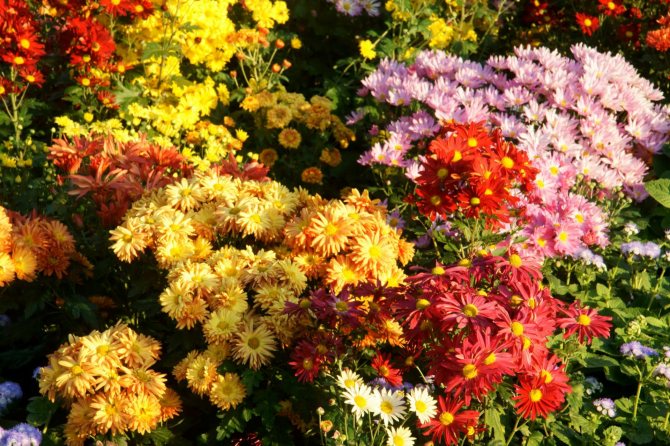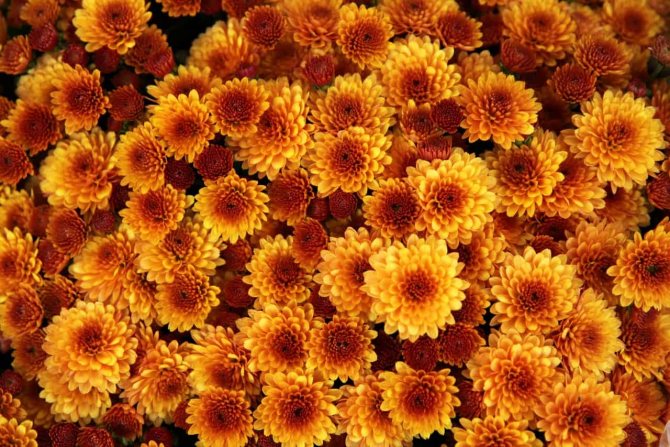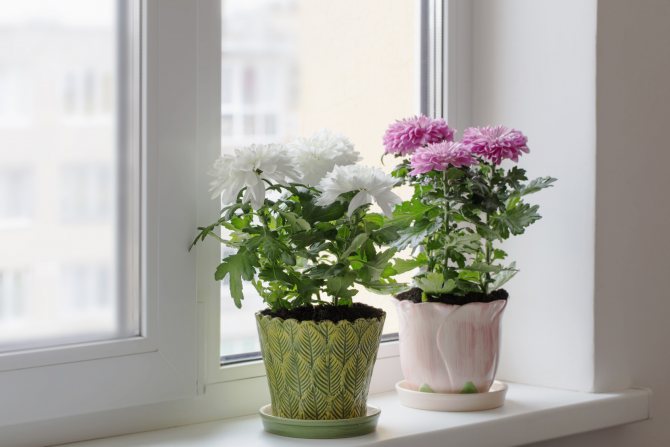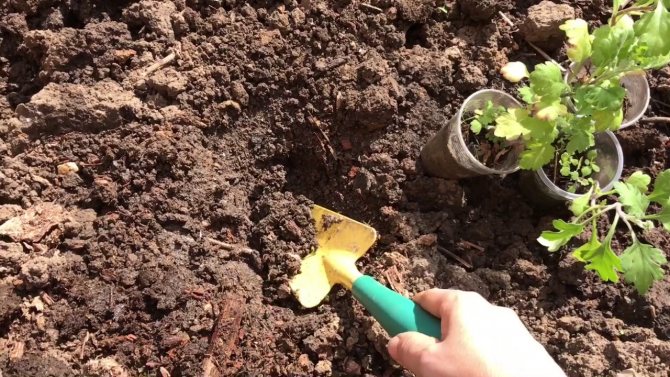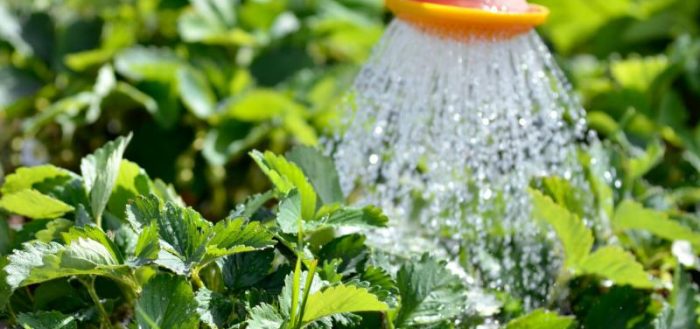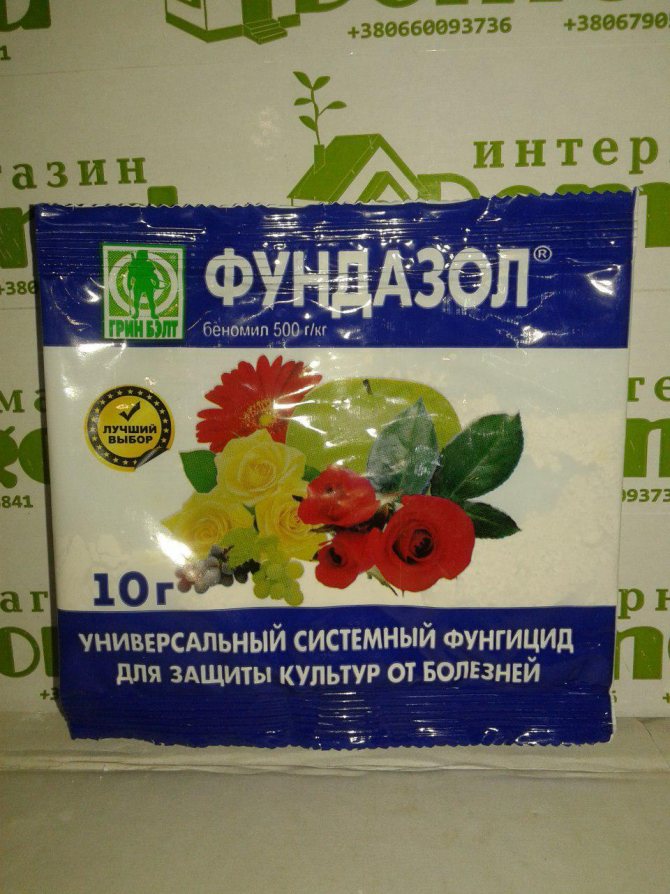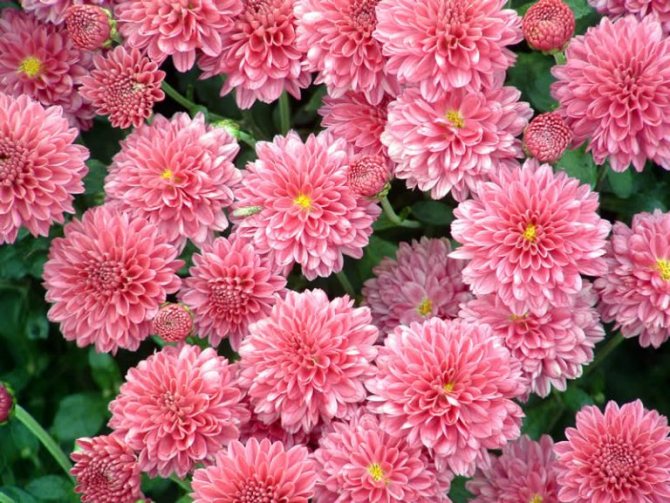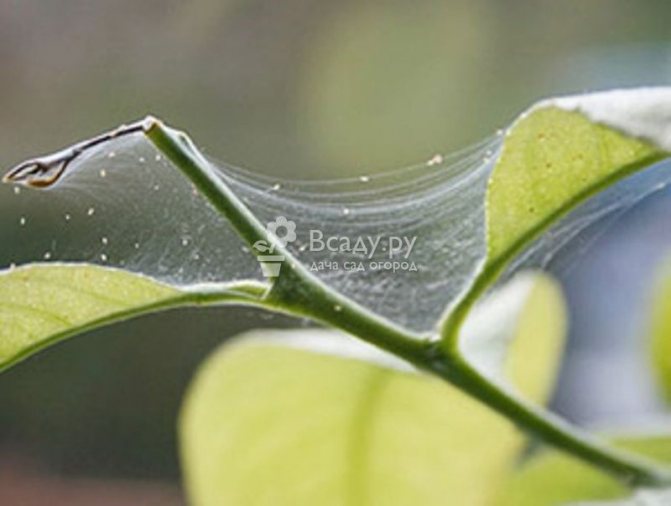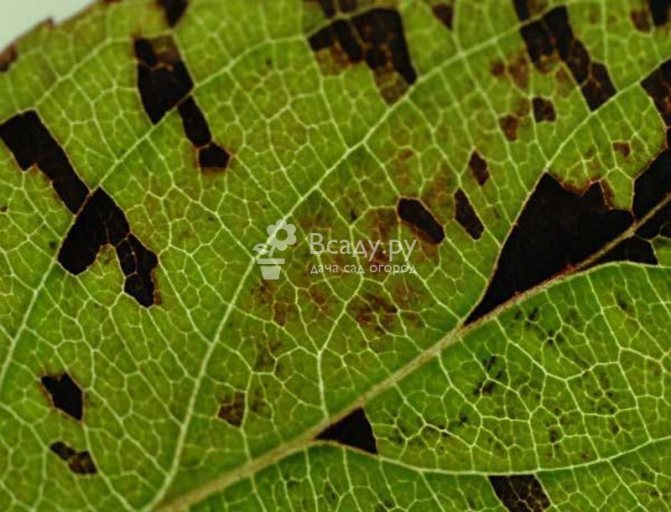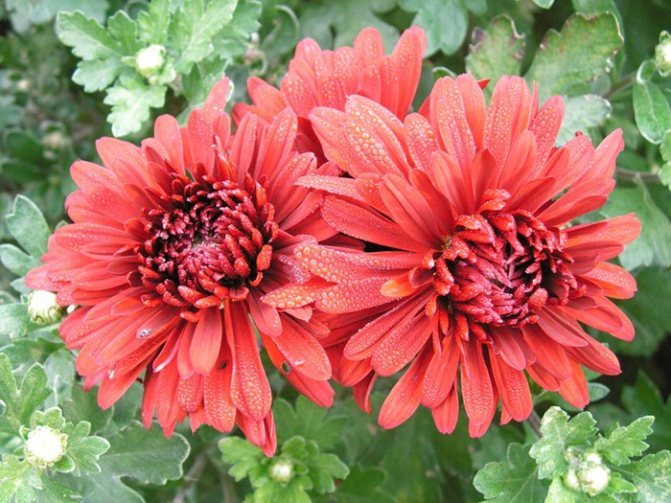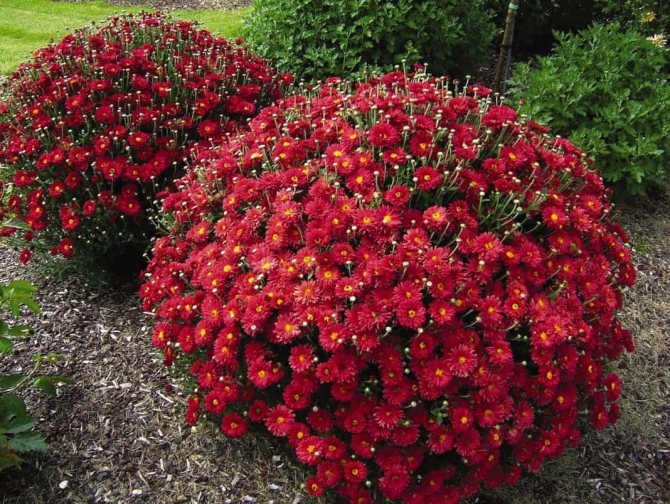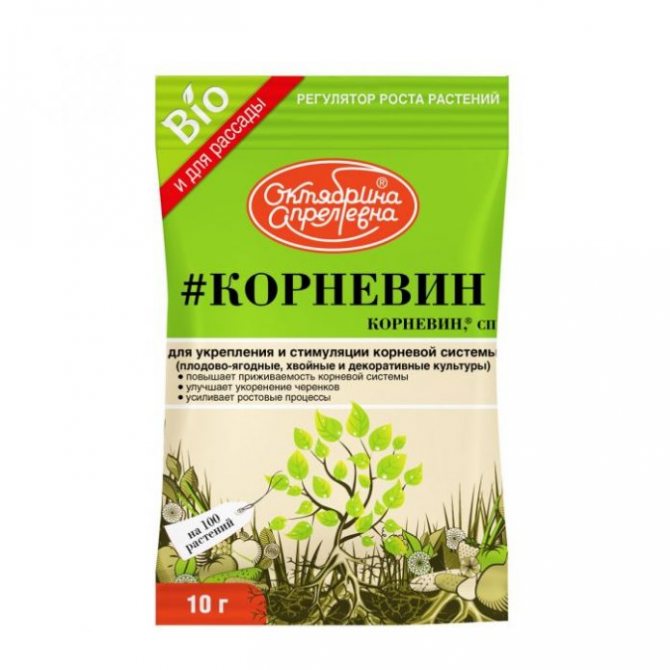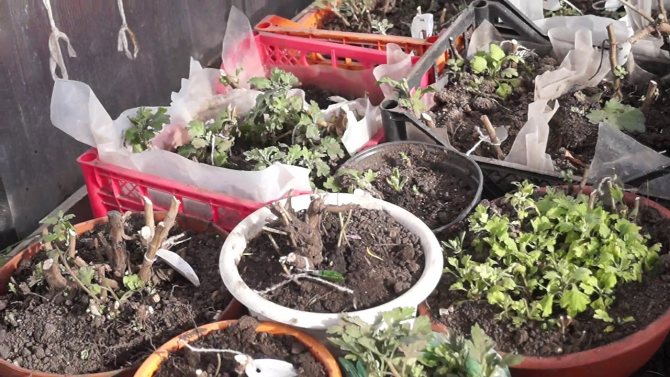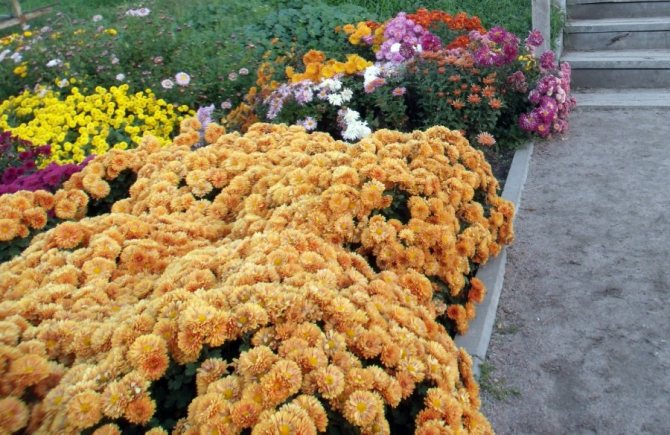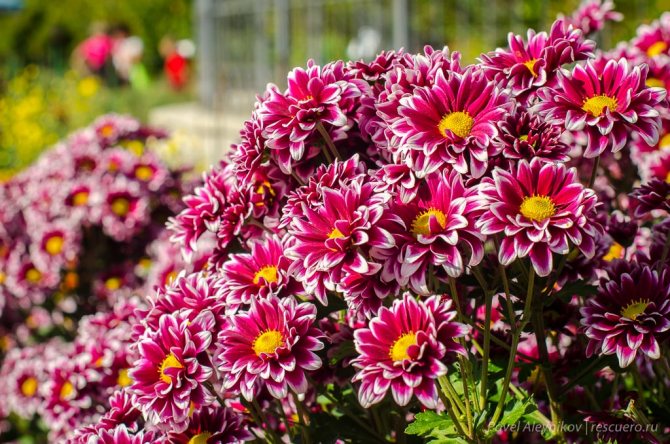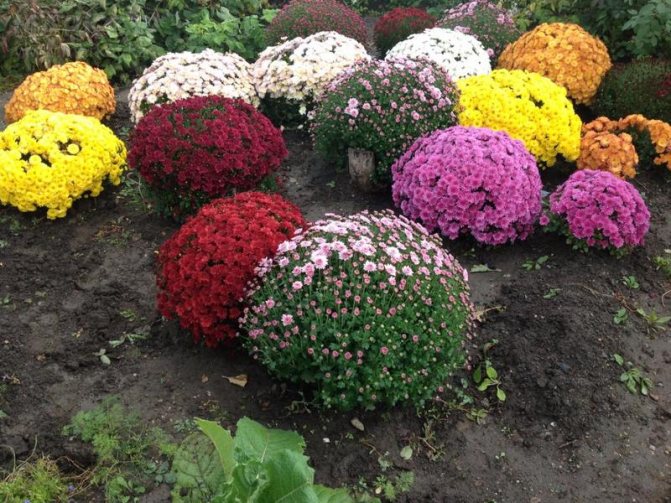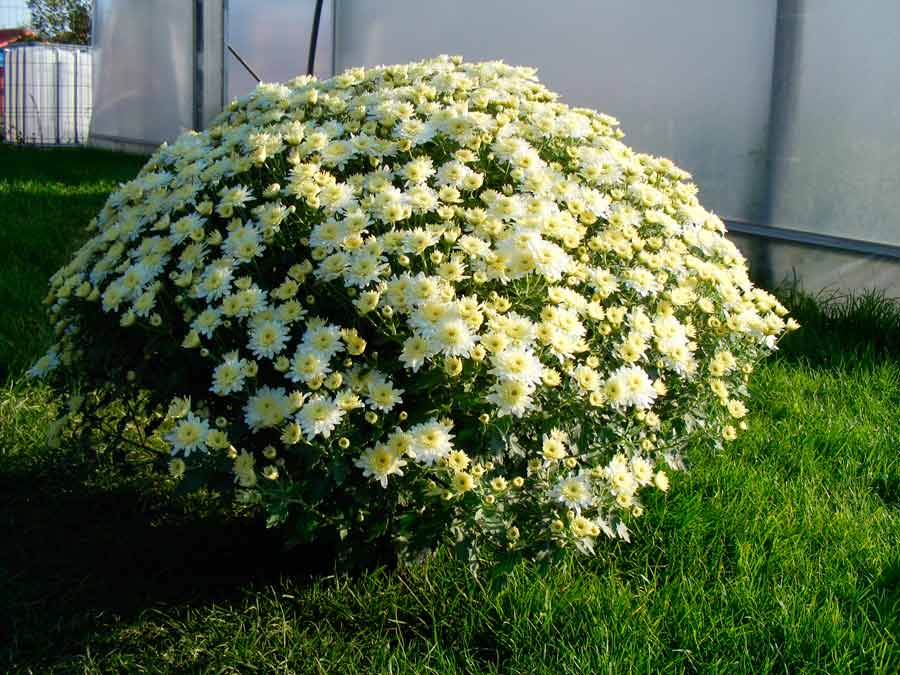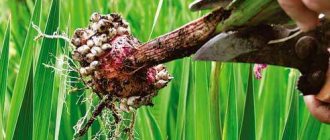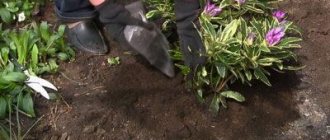With the onset of autumn, beautiful chrysanthemums begin to bloom in flower beds. For a long time, until the very frost, they decorate the garden. If the climate is mild, then you can admire their bloom right up to the snow. An autumn transplant of chrysanthemums is a great way not only to prolong flowering, but also to protect them from freezing.
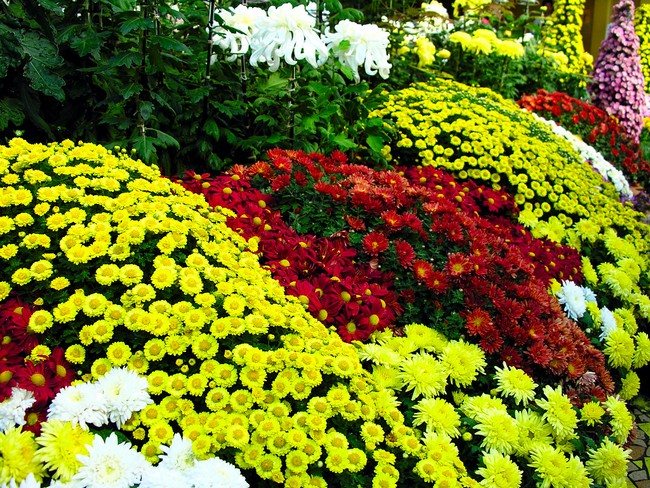
Methods and timing of reproduction of chrysanthemums
Chrysanthemums are annual - they are grown annually from seeds, and perennial - they can be propagated by seeds, cuttings, mother plants or by dividing a bush. Chrysanthemums are planted in spring and autumn, each season has its own advantages:
- Seeds sown in open ground in May, and when the seedlings grow by 10 cm, they are pinched. In the fall, chrysanthemums are already blooming
- Cuttings Is a very popular breeding method for chrysanthemums. You can grow a bush by cutting off a stalk even from a bouquet. How to root a chrysanthemum shoot? A shoot about 6 cm long is rooted in a soil consisting of sand and peat. The box covered with glass is kept in a cool place, not higher than + 15 ° C. When the roots appear, the plants are planted in separate pots and then, with the end of the frost, in the open ground. If you purchased a cuttings of the desired variety in the fall, do not plant it in the ground, but root it in a container and leave it in a cool room until spring
- Uterus - this is the overwintered rhizome of chrysanthemum, from which shoots will go, it can be purchased and planted in early spring
- Dividing the bush - the only way to plant chrysanthemums in autumn, in which the plant is carefully dug up, the roots of the mother bush with shoots are divided into several specimens with pruning shears and planted. This procedure is supposed to be carried out every two years to rejuvenate the plant.
How to properly transplant into a pot
There are varieties of culture that should be transplanted into pots for the winter and brought into a cool room.
The size of the container is matched to the size of the excavated culture. If the plant is small, a 10 cm pot will do. When transplanting three bushes at the same time, a pot with a diameter of 12 centimeters is taken. If 5 cuttings are planted, a 15 centimeters container will do.
In a group transplant, plants are selected in height, placed along the edge of the container, tilting them outward.
Chrysanthemums, planting in spring and autumn
Please note that if you decide to grow chrysanthemums, planting and care in the open field differ in spring and autumn - with spring planting, mother plants and cuttings take root better, but in autumn you can choose a flowering bush and not be mistaken with its appearance.
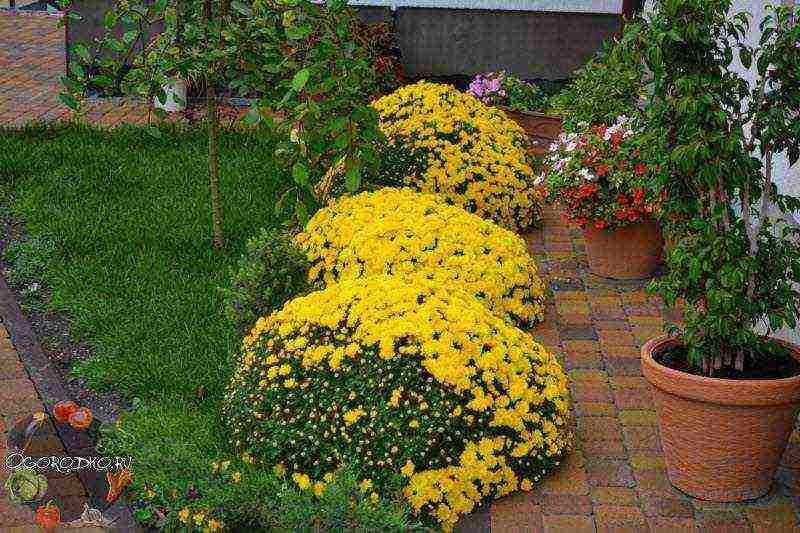

In very frosty winters, choose Korean small-flowered hybrids of chrysanthemums, which are nicknamed the oak - this species unites many varieties zoned in the middle lane and the Moscow region. Large-flowered Indian chrysanthemums are tall - they grow up to a meter, and sometimes up to one and a half, but they are afraid of cold weather and easily freeze out.
For chrysanthemums, choose a sunny, preferably elevated place. Flowers do not like stagnant moisture, therefore, the waterlogged soil is drained by adding a layer of coarse river sand to the planting hole. The soil is preferable slightly acidic or neutral, light and loose. Too dense - mixed with peat, humus or rotted compost.
Chrysanthemum plants are placed every 30-50 cm.A shallow hole is dug so that the shoots on the mother plant or two-thirds of the cuttings are not covered with earth, when dividing the bush - this is about 40 cm.No more than 0.5 kg of humus or compost is added to the hole. If you overdo it with fertilizers, the flowers will be small, and only foliage will be lush. It is recommended to water the roots with a stimulant (Epin, Kornevin, Heteroauxin), and then cover it with soil and compact it. After spring planting, it is advisable to cover the cuttings from the sun with a spunbond for a couple of weeks.
When planting in autumn, the chrysanthemum bush must be watered abundantly, this will compact the soil, eliminating voids in it, because of which the roots can freeze. In addition, the flowers are cut and a third of the stems are left for the nutrients to go into the development of the root system.
Chrysanthemum transplant outdoors
Since chrysanthemums are perennial plants, they are able to withstand a long period of cold weather even in the open field. In this case, it is very important to move the flower to another place from time to time. Thanks to this, chrysanthemums will grow and develop normally, and the flower bed will retain its attractive appearance.
The transplant procedure is usually carried out immediately after the snow melts. For the result to meet expectations, it is important to know how and when to transplant chrysanthemums correctly.
How to transplant chrysanthemum in spring
Since chrysanthemum is characterized by active growth, in the process of development and formation of a flower, the soil under it is greatly depleted, the amount of nutrients in it is sharply reduced. This situation will ultimately have a negative impact on the state of culture. Therefore, the plant must be periodically moved to another location.
When is it better to transplant chrysanthemums - in spring or autumn? Experienced gardeners recommend the first option, since transplanting chrysanthemums is stressful for them, and if you move flowers before the onset of cold weather, they will not get strong enough and risk not surviving the winter. The second reason: the spring transplant is a fairly simple event. In the spring, after the snow has melted, the soil is moist and soft - under such conditions, it is much easier to dig up a flower. In addition, the likelihood of damage to the root system is reduced, while removing the crop from hard, frozen soil in the fall is difficult and leads to root injury.
Transplanting must be done before the plant begins to wilt due to the impoverished soil. This must be done in advance, until the flower withers. At first, when the age of the flower does not exceed 2-3 years, the transplant is carried out once a year. Further, the procedure is carried out every 6 months.
The exact time of the work depends on the climate, but in any case, the plant can be “relocated” only at the moment of warm weather.
Note! It is recommended to replant the culture on cloudy days.
The transplant process includes the following sequence of actions:
- Choosing a landing site. Beds exposed to sunlight are best suited for this. Groundwater should not pass too high, otherwise a little sand should be added to the holes.
- Flower preparation. Before removing the culture, it is recommended to moisten the ground, then it will be much easier to dig up the chrysanthemum and the roots will remain intact. Before transplanting, the bush is divided into several parts, cutting in such a way that roots with shoots are present on each part.
- Transfer. In advance, you need to prepare holes, the depth of which would be 18-22 cm, and the distance between them was at least 50 cm. Having placed flowers there, chrysanthemums are sprinkled with earth.
- Watering. For the first 2-3 weeks, the soil in the new place is thoroughly and regularly moistened, preventing stagnation of the liquid.
- Top dressing. Fertilizers can be applied 2-3 days after transplanting. As such, nitrogen and phosphorus compositions are used.
It should be borne in mind that only winter-hardy plant varieties are allowed to transplant in this way. Chrysanthemums dug out before the onset of cold weather and planted in pots, which were in the basements in winter, must be prepared in advance.
Autumn transplant
Chrysanthemum is a rather delicate plant and, despite its winter hardiness, it is still sensitive to cold weather. In order not to cause harm when transplanting chrysanthemums to another place in the fall, it is important to follow all the necessary recommendations.
- Before you "relocate" the chrysanthemum, you need to choose a good place for it. As such, a sunny plot of land with deep groundwater is suitable.
- The soil in the new location should not be too acidic.
- Hard and heavy soil should be fertilized with manure, peat or compost.
- The roots around the bush are pruned with a shovel, due to which there will be a rapid growth of roots, which will easily take root in another area.
- Before removing the chrysanthemum, the flower in the old place is watered with plenty of water. Then the culture is moved along with the excavated piece of soil.
- After transplanting, fertilizers are applied to the soil.
- 2 weeks after transplanting, the soil is filled up (the old one by this time will noticeably sag due to watering).
- The soil in the hole does not need to be pressed down strongly, otherwise the roots may be damaged and the plant will not take root.
Planting chrysanthemums in a pot
When preparing the land, it is important not to overdo it with feeding. An excessive amount of fertilizer will negatively affect the condition of the flower: as a result of too active growth, the culture will quickly fade and wither before the onset of winter.
The whole procedure is carried out before the onset of cold weather.
Chrysanthemums, care - watering, feeding, pruning, shelter
Chrysanthemum cannot stand moisture stagnation, but loves watering - without water, the stems become tough, the flowers become smaller. At the same time, the flower does not tolerate sprinkling, it must be watered at the root, preferably with rain or settled water. After watering, the soil is loosened to avoid crusting.
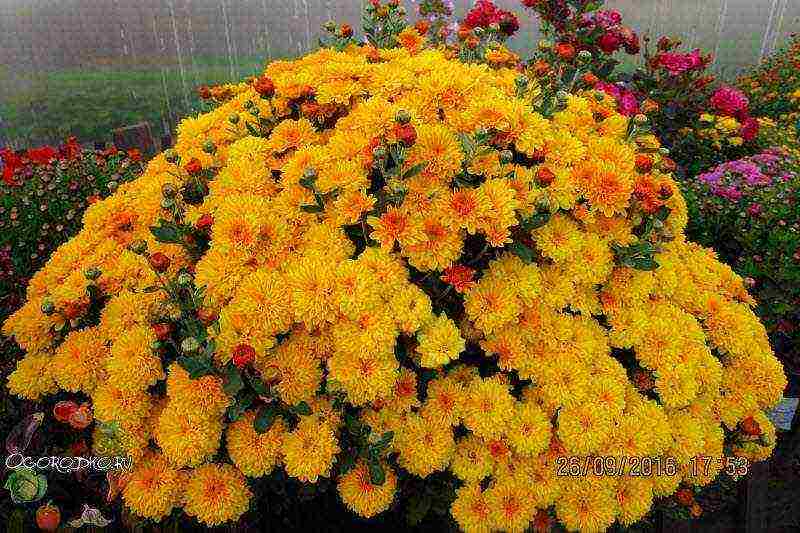

In spring, for chrysanthemums, nitrogen fertilization is necessary for rapid growth; it can be carried out 2-3 weeks after planting. In the second half of summer, with the beginning of chrysanthemum budding, phosphorus-potassium fertilizers are applied to ensure lush flowering and strengthening of plants before wintering. In the fall, you can feed the flowers a little with organic matter. Tall varieties are tied up, as their fragile stems can break.
The onset of frost is a signal that it is time to leave for the winter. The trunks of chrysanthemums are cut in late autumn, leaving 10-centimeter stumps and insulated with sawdust or foliage. The most delicate varieties are wrapped on top with a covering material and something flat is placed on top to protect it from moisture - for example, a plywood board. Some growers dig up the roots and store them in a dark, cold cellar in winter to make sure the variety is preserved.
Reproduction methods
There are several ways of reproduction: cuttings, division or root shoots, which are separated from the mother bush. You need to plant a flower in spring or early summer, in extreme cases in early September, before the first frost.
How to grow chrysanthemums from a cutting
In general, cuttings can be rooted at any time from May to the end of September. They got a sprig of chrysanthemum at least 8-10 cm long - root it on the site, covering it with a film to maintain moisture. You can place the container with the handle somewhere in the shade, or simply cover it with the cut-off top of a plastic bottle. Water with Kornevin or place in a heteroauxin solution for 4-6 hours before planting. After a couple of weeks, the plant will give roots, which means you can transplant to a permanent place of "residence". Cover the cuttings for a week so that they take root better.
Cuttings planted in open ground before September will tolerate wintering well if they are simply covered with sawdust.
Irregular watering and a lack of moisture in the chrysanthemum will lead to lignification of the stem, deterioration of the quality of flowers, and loss of decorative effect.
If you cut chrysanthemums in June, blooming chrysanthemums will delight you for the New Year. Plant the cutting in open ground under a glass jar or plastic film, while pinching the top. At the end of November, plant in pots and transfer to a warm and bright place.
How to root chrysanthemum cuttings from a mother plant
For successful rooting of cuttings, it takes about 20-30 days, plus hardening for 2-3 weeks - these are the approximate terms for cutting from a mother plant of a chrysanthemum. A month before the start of cuttings (January-February, for late varieties, the period is shifted by 2-4 weeks), prepare the mother plant: gradually increase its storage temperature to 16 ° C, water regularly (only at the root) and after watering every 2-3 weeks fertilize with a solution of nitrogen fertilizer (10-15 g per bucket of water). This is done so that the plant has strong young shoots. After each watering of the plant, mulch with peat, so you will retain moisture as much as possible. For cuttings of chrysanthemums, it is better to use shoots of 2 or 3 orders; root shoots will be a good option for cuttings.
Chrysanthemum cuttings are obtained from young shoots, which have 10-12 leaves. Under the knot of the leaf, break off the top of the shoot 5-7 cm long, so that there are 3-4 leaves. Leaves that need to be removed from the bottom, and check that the stalk does not begin to woody.
Cuttings are planted only healthy ones. If you see aphids on it, treat it in a soapy solution, rinse it, dust the slices with charcoal. Start planting in boxes with a soil layer of 5-6 cm and a 2-3 cm layer of washed river sand on top. They are planted in the soil to a depth of 2-3 cm at such a distance that the leaves touch each other a little. Sprinkle with water and cover with foil or glass. Place the cuttings in a room with a temperature of 15-16 ° C for further rooting.
If your soil is not ideal for growing chrysanthemums, then dig it up in the fall and fertilize it with sawdust, humus and old leaves. In the spring, start planting chrysanthemums from cuttings. The readiness of chrysanthemum cuttings for planting in open ground is determined by the appearance of the top of the stem.
Before planting, the cuttings are hardened by airing or taking the boxes out into the street, they are covered with foil at night.
Fertilize the soil with urea, make holes a distance of 30-50 cm between them. If possible, dig a small trench nearby for the convenience of further watering. Water the cutting, set it in the hole, so that the root collar is about 5-7 cm in the ground. Moisten the soil well and cover it with mulch in case of a possible cold snap. The shelter can be removed when the temperature is stable outside at night. 5-6 days cuttings shade a little during the day from the scorching sun.


How to grow chrysanthemums from seeds
The goal is to get a lot of quality seeds. The easiest way to get chrysanthemum seeds is from small-flowered non-double or semi-double varieties. It is better not to have affairs with large-flowered ones, most likely there will be no sense.
Those plants from which you are going to get seeds should be planted earlier than usual. Caring for chrysanthemums from seeds is usual: regular loosening, watering, feeding, spraying, pinching and be sure to pinch. To get better quality seeds on one stem, you need to leave only one inflorescence. You need to pinch once, removing the spring bud.
With the onset of autumn, rainy and damp weather begins, so it will be logical to install a light film cover over the chrysanthemums so that the inflorescences are not wet. You can immediately transfer it to the greenhouse, if this is not possible, then leave the plants in the open field until the onset of frost, and then transplant the testes into containers for growing, placing them in a warm place in a well-lit place.
If you transferred the seed plants to the greenhouse, then protect the inflorescences from condensation by pulling gauze over them. If you are growing chrysanthemums with long corollas, then regularly cut the petals in half to improve ventilation and give as much light as possible to the receptacle (where the seeds are located). Ripening, regardless of location, takes place until December.
You need to sow seeds in open ground in May in order to wait for flowering in August. 3-4 seeds are laid out in one hole. The holes are made at a distance of 25 cm.
In June, flowering will begin if the seeds are sown in March in a heated room. Pick the grown plants and transplant them into open ground in the last days of May.
If you buy seeds, then it is best to sow seedlings in early March in boxes 6-8 cm high.Pour in a nutritious soil mixture: white peat, humus and sifted greenhouse soil (all in equal proportions), ignite at a high temperature of 120-130 ° C, so you will disinfect. Spread the seeds over the surface and sprinkle with a layer of vermiculite, about 7-10 mm. Moisten and cover with glass or clear film. Leave at a temperature of 16-20 ° C and in 10-14 days you will have the first shoots. Then you water, feed, provide good lighting and dive into the seedling pots when 3-4 leaves appear. Transplant into open ground in May according to the scheme 15 × 30 cm or 20 × 30 cm. Cull weak plants as they grow. In the first year of growing, keep the chrysanthemum in a single stem form, this will strengthen it.
How to create globular chrysanthemum bushes
For flowers such as chrysanthemums, planting and care in the open field is not all that is needed and simple processing will allow you to create real masterpieces from them.
Chrysanthemums after winter are pruned and pinched to get a beautiful spherical bush. There is a variety in which the bush itself grows in the form of a ball, without needing to be formed - this is chrysanthemum multiflora, a low-growing bush up to 20 cm in height - when two pairs of leaves appear on the shoot, it is pinched, and then the ball forms itself.


Multiflora can be grown not only in a flower bed, but also in a pot. But, at the end of flowering, the aerial part of the plant is cut off and sent to rest - in a dark, cool place, for the whole winter. Periodically dormant chrysanthemums are watered so that the roots do not dry out. In February, the first shoots appear, which means that the plant has woken up, and it is time to get it out of the basement. If a spherical chrysanthemum grows in a flower bed, the stems should be cut to 10 cm and covered with sawdust and non-woven fabric for the winter.
Multiflora loves soil rich in fertilizers, add more humus and wood ash to the hole when planting. If you grow it in a pot, you can prepare the soil from 30% humus and 20% sand, the remaining 50% is sod land.
You can also form a ball from other types of chrysanthemums, in small and medium-flowered ones, the main shoot is pinched when it reaches 10-12 cm, then the lateral shoots that have grown to the same length are cut off, they then actively branch, pinching is done until the buds appear.
In large-flowered species of chrysanthemums, stems 15 cm long are cut, in total one or two pinches are carried out no later than June, in addition, they are stepchildren - from mid-July, shoots that appear from the leaf axils are removed daily, and starting from August - every three days, then you can get a spherical bush with large flowers up to 10 cm in diameter.
Chrysanthemum is a representative of the Asteraceae family, combining herbaceous forms and dwarf shrubs, perennials and annuals. It was brought to us from Japan, where it is considered the state flower and is depicted on coins and the state emblem. Among the variety of forms there are indoor, garden and varietal, designed for cutting and creating bouquets.The flower is unpretentious, it is very popular both among gardeners and among buyers - chrysanthemum ranks second in the number of plants grown for making flower arrangements, after a rose.
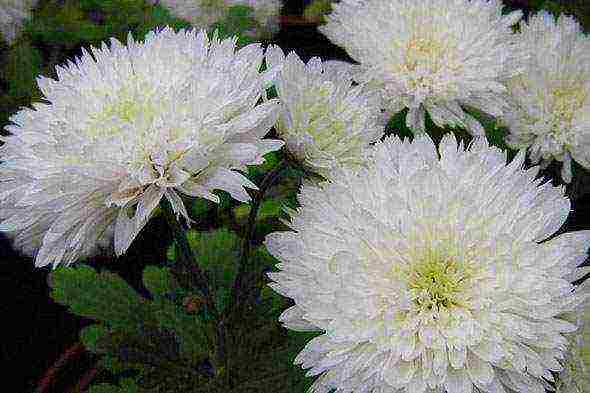

Possible Diseases - Why Chrysanthemum May Not Bloom
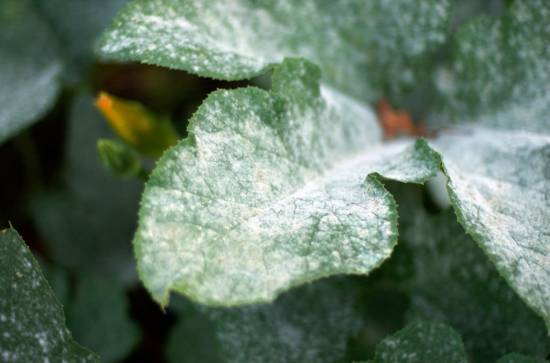

Without proper care, the flower can suffer
Chrysanthemum grows well and practically does not get sick. But due to improper care, the flower can still suffer. Among the main diseases are the following:
- Gray rot that appears as a fluffy coating or brown spots on leaves and stems. This disease is provoked by an increased level of humidity.
- Powdery mildew. It can be recognized by the white bloom on the buds and leaves. The cause is excessive moisture.
- Septoria is a lesion by fungal microorganisms. The disease can be detected by the dark brown spots on the leaves with a yellow border. It appears as a result of excessive use of nitrogen fertilizers.
- Spider mite. Its presence is evidenced by the light yellow color of the leaves.
- Aphids attack stem tops, leaves and buds. Damaged parts turn yellow and fall off.
- The thrips are located on the underside of the leaves, and light dots appear on top. The reason is low air humidity and high temperature levels.
Inadequate care can also be the reason for the lack of flowering. This happens under improper lighting. Chrysanthemum loves sunlight, but in moderation. Untimely germination can also lead to such consequences.
Chrysanthemum is an unpretentious culture. It can be successfully grown indoors. To cultivate a healthy and beautiful flower, you need to adhere to some rules regarding lighting, temperature, feeding and watering.
Chrysanthemum transplant in autumn
is the best way to enlarge a flower bed or arrange a new flower garden. Chrysanthemums transplanted for the winter will root well, which means they will take root in a new place. Transplanting flowers will not be difficult. The basis for a successful transplant is the correct choice of the site. Chrysanthemums are transplanted where there is a lot of sunlight. The ideal place for a flower bed is a hill or dry, level area.
Types by flower size
Blooms from late summer to late autumn. Depending on the size of the flower, there are:
- Large-flowered chrysanthemum (height up to 130 cm, diameter up to 25 cm) is a luxurious look with large flowers, most often used for cutting. It does not tolerate winters in the open field, but recently varieties capable of this have been bred. Common varieties are Anastasia Green, Zembla Lilak, Tom Pierce.
- Mid-flowered chrysanthemum (height up to 75 cm, diameter up to 15 cm) - flowers are more often collected in inflorescences than single ones. Used for decorative purposes in gardens, parks, planted in open ground, flowerpots, bowls. It can be used for landscaping terraces, balconies or for cutting. Popular varieties: Golden Fleece, Pink Chamomile, Champagne Splash.
- Small-flowered or perennial Korean chrysanthemum (height up to 1 m, diameter up to 8 cm) - bush form, has dark green foliage, popularly called "oak", because resembles oak leaves in shape. Flowers are arranged frequently, up to 100 pcs. on one plant, of the most varied colors. It blooms from September until late frost. Unpretentious, tolerates frost well, reproduces by dividing the bush. The best varieties for the garden are Multiflora, Etna, Slavyanochka.
Description of culture
Potted chrysanthemum will decorate any home
Chrysanthemum belongs to the Aster family. It is a perennial shrub with straight stems. Its flowering period lasts from September to October. Plant height varies from 15 cm to 150 cm. Inflorescences can be of various shapes, depending on the variety.The leaves are gray-green in color.
The number of varieties of chrysanthemums reaches 150. But not all of them are suitable for growing indoors. For this purpose, you need to select low-growing species of silky, Chinese, Indian or Korean chrysanthemums. These varieties are characterized by abundant flowering and small size. The height of chrysanthemums is 15 cm - 70 cm. Inflorescences are divided into large and small species. For home cultivation, varieties such as Sharm, Minimum, Cascade, Chrysanthemum, Orange Jam, Stella, Navare, Helen, Aurora, Snow Elf, Altgold are especially popular.
Growing methods
In the conditions of the Moscow region, chrysanthemum can be grown in three ways:
- from seeds,
- dividing the bush,
- by cuttings.
By dividing the bush, perennial species breed. In the spring, when the threat of frost has passed, we dig out the main bush, carefully separate the young shoots and immediately plant them in a previously prepared trench, water abundantly.
Chrysanthemum can also be grown by cuttings. In the spring, it is necessary to cut off the green shoots coming directly from the root (the lateral ones will not work), treat the lower part with "Kornevin" and plant in the ground. It is recommended to protect the stalk from the sun with a covering material. You can take a newspaper, or any non-woven material.
Seedlings from seeds. This method is used when planting annual varieties, as well as if you want to achieve early flowering or breed a new perennial. Planting is done in shallow boxes with pebble drainage at the bottom. You can choose the soil ready-made in the store, or prepare it yourself: mix peat, humus and greenhouse soil in equal proportions. Spread the prepared substrate over the drainage in an even layer, place the seeds, press the perennial varieties with a finger, without the top layer, and sprinkle annuals with a thin layer of soil (0.4-0.6 cm). We spray, cover with glass or film, the optimum temperature for germination is 23-25 ° C. Seedlings are expected in 1.5-2 weeks. In the phase of two true leaves, we make a pick of the seedlings.
When to transplant chrysanthemums at home
A garden mixture is great for transplanting home flowers. Fertilizers are used as top dressing, consisting of peat, humus and earth in the same proportion. Since the root system of the plant is shallow, the transplant box may not be too bulky. The floor of the container must have drainage holes. Before transplanting, it is recommended to disinfect the soil with formalin or warm it up.
Potted chrysanthemum purchased in October should not be placed outdoors immediately. Most likely, the plant will not have time to take root in a new place before the onset of winter and will die. Therefore, it is best to leave the flower in a pot and store it in a warm room until spring.
After the end of flowering, the flower is cut off, leaving about 15 cm on the surface of the box. The container is wrapped in a thick layer of fabric so that the culture does not germinate prematurely. In this form, the plant is sent to the basement or cellar for wintering. The moisture content of the soil should be minimal. In the spring, the container is transferred to a warmer and lighter place. By this time, the chrysanthemum will begin to give its first shoots. As soon as the threat of frost has passed, the flower is moved from the pot to fresh soil.
A week after transplanting, the flower is fed with a nitrogen-containing fertilizer. The next feeding is carried out every 10 days. As soon as shoots with several young leaves appear, the tops of the plant are pruned, creating conditions for the future formation of the bush.
Note! There is an alternative - at the beginning of spring, you can transfer the chrysanthemum to the light and propagate by cuttings.
Cultivation and maintenance
Chrysanthemum is a short day plant, i.e. the formation of flowers directly depends on the duration of the light period, thanks to this it is easy to forcing (flowering at an unusual time for it).To form a beautiful spherical bush, it is necessary to pinch the central and lateral shoots.
When choosing a place for planting, pay attention to the fact that the flower loves bright, diffused light, but it must be closed from the midday sun.
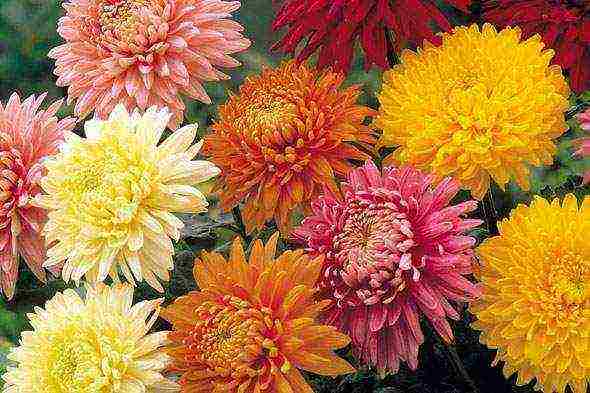

Watering is moderate, as needed, with soft, settled water, at the root. Spraying can be done infrequently, but more for hygienic purposes, and not for moisturizing.
Chrysanthemum is very friendly in relation to the neighborhood with other plants, goes well with marigolds, asters, zinnia, cosmea and balsam.
Planting in open ground is more often carried out in the spring, when the possibility of night frosts has passed, but it is also possible in the fall. A shallow trench is being excavated, because the rhizome grows in a horizontal plane, a spill is made, the plants are laid out at a distance of 20-50 cm from each other, depending on the variety, and, in fact, the planting is carried out. After that, it is advisable to pour them with Kornevin's solution in water for better and faster development of the root system. To create a lush bush, the plant must be pinched. If the day is sunny, protect the newly planted flowers from the sun.
The flower needs constant feeding, the intensity and frequency of flowering depends on it. During the growing season, they feed at least 3 times - alternately organic and mineral fertilizers. Of the latter, it is better to first choose nitrogenous ones - to form a powerful green mass, and during the budding period - phosphorus-potassium ones, to stimulate intense flowering. Organic - mullein and bird droppings can be applied between minerals, the main thing is not to burn the plant. You can use complex fertilizers.
Chrysanthemums need soil mulching - pine bark, sawdust, needles are suitable as mulch. This process slows down the formation of weeds around the plant, protects against parasites.
Spring transplant
Transplanting chrysanthemums at this time of the year involves dividing the bush. All work is done in stages and consists of the following activities:
- Choosing a site for a flower bed. It is best to choose an area that is well lit by the sun's rays. Groundwater should not be located very close to the ground surface. But, if there is such a problem, then coarse sand must be added to the holes. This will provide the transplant site with a drainage system. Before transplanting, dig up the flower bed to the depth of a shovel bayonet and remove all plant debris.
- Preparation of bushes. If the soil in the flowerbed has dried up before the transplant, then it must be abundantly moistened. So the chrysanthemum is easily removed from the ground and its roots are not damaged.


- Division of the bush. After removing the chrysanthemum, gently shake off the soil from the roots. Then take a sharp knife and divide the uterine bushes so that a root with shoots remains on each part.
- Transfer. Dig holes 50 cm apart. They should be 18-22 cm deep. Carefully spread the roots of the seedlings, place them in the holes and sprinkle with a nutritious composition, that is, earth mixed with peat or humus. Lightly tamp the soil with your palms.
- Water the bushes with water. For this, it is better to use settled or rainwater. Make sure that drops do not fall on the foliage, as this can negatively affect the decorative effect of the bush.
In the first few weeks after transplanting, the flower bed should be moistened as often as possible. In this case, it is important not to allow stagnation of water, otherwise the roots will rot. After 2 weeks, fertilization is permissible. For chrysanthemums, liquid mineral supplements containing nitrogen, phosphorus and potassium are suitable. Do not forget about loosening, this will saturate the roots of the plant with oxygen.
It is worth noting that only frost-resistant varieties that have wintered in the open field should be transplanted in this way in the spring. Bushes that have been dug up, planted in a pot and placed in the basement must be prepared in advance.They need time to get stronger and adapt to the new temperature regime. To do this, pots with bushes need to be moved outside 7-10 days before planting. Further, the transplant and further care is carried out in the above way.
Diseases and pests
Chrysanthemum attracts with its beauty not only people, but also insects, some of which have a destructive effect on it. For example, aphids and meadow bugs, both adults and larvae, suck sap from the plant, after which it turns yellow, loses leaves, and lags behind in development. Another uninvited guests are nematodes, it is useless to fight them, but it is possible to carry out prophylaxis before planting - treat the plants with a solution of phosphamide, and the ground with formalin.
Sick plants are removed and burned in the fall.
When snails and slugs appear, they must be removed.
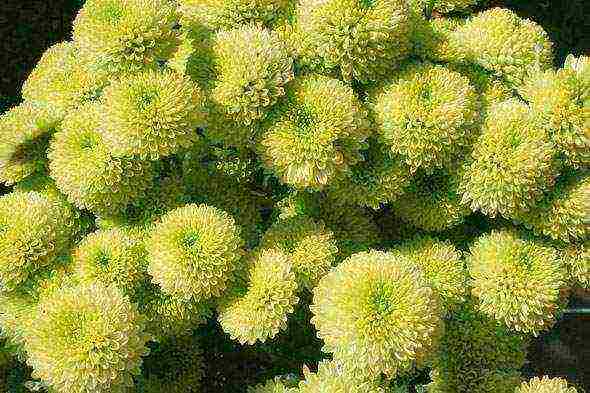

Chrysanthemums are characterized by viral diseases - dwarfism, mosaics, which cannot be cured, they must be detected in a timely manner and the affected specimens must be removed. Fungal diseases - gray rot, rust, powdery mildew - are treated with preparations containing copper.
How to protect chrysanthemum from frost
If you grow chrysanthemums by cuttings, then in October, install a frame on the site and stretch a film over it - this will be protection from frost.
Young plants are stored in a cool room at above-zero temperatures until February, then exposed to light and heat. It can be stored in the house, but then periodically you need to pinch the plants, otherwise the shoots will stretch out into growth. The preparation "Athlete" slows down the stretching of shoots.
When aphids and ticks appear:
- use insecticidal preparations Actellik and Ratibor;
- you can try to get rid of aphids with flea drops. Dilute 2-3 drops in one glass of water and spray the plants. Repeat the procedure after 3-4 days;
- wash with soapy water every 7-10 days;
- with the help of pyrethrum: 200 g of the drug for 10 liters of water, leave for 12 hours. Take 50 ml of the concentrated solution, add 50 g of soap and pour 10 liters of water;
- extract from garlic is effective: crush 50 g of garlic and pour 1 glass of water. Strain after 20 minutes and bring to 1 liter with water. In the evening, take 1.5 cups of the infusion in a bucket of water and wash the plants.
Once again, you can clearly study the features of caring for chrysanthemums, consider in detail the methods of plant propagation, you can watch the following video.
Wintering
As already mentioned, large-flowered specimens cannot survive the winter outdoors, therefore, when cold weather sets in, the bush is cut off (the ground part is 10-15 cm) and the rhizome is sent to a cool place (0-5 ° C) for wintering. With the onset of heat, disembarkation is made.
The small-flowered form tolerates winter well without shelter, with the exception of young individuals.
It's not so difficult to create a bright autumn - plant several chrysanthemum bushes on your site and they will delight your eye with juicy, bright, varied flowers, dream up - create a shape you like, experiment - make a flower forcing by March 8, this will be a wonderful gift!
Perennial garden chrysanthemum - planting and care, photo in pots
The rich heads of the bushes of blue, burgundy, yellow, purple decorate the gardens until the first snow, when other plants have long withered. Therefore, among gardeners, another name for chrysanthemum is known - the queen of the autumn garden. This is what chrysanthemums are called.
Types and common varieties of chrysanthemums
Perennial chrysanthemums are divided into two large groups according to the size of the inflorescences. Each of them includes many different varieties.
Chrysanthemum Korean Froggy
Small-flowered
These include the Korean chrysanthemum, the planting and care of which are discussed in our material. The size of the flowers varies from 2 to 10 cm, the shape of the leaves resembles that of oak, but much smaller.Flowering begins in early autumn and may continue until frost. Popular varieties of chrysanthemums in the Moscow region: Cheburashka, Talisman, Multiflora.


Chrysanthemum Korean Multiflora
Large-flowered
Tall plants with large single (10-25 cm) flowers, intended for cutting. They do not tolerate a sharp drop in temperature, they often freeze and die in the open field, therefore, in the Moscow region, they are almost never used as garden ones. Common varieties in the southern regions of Russia: Orange ball, Valentina Tereshkova.
Chrysanthemum large-flowered Valentina Tereshkova Perennial chrysanthemums - planting and care in the open field
It is recommended to transplant pre-purchased or home-grown seedlings into open ground in late May - early June. Chrysanthemums are very fond of the sun, so even a light partial shade is not suitable for them - the plant will bloom poorly and may die.
The composition of the soil should be rich in organic matter and breathable, therefore, when preparing a flower bed for chrysanthemums, it should be dug deeply - by 50-60 cm.Pre-add manure and humus at the rate of 0.5 buckets per 1 sq. At the same time, it should be remembered that too much organic matter content provokes foliage growth, while flowering is scarce and scarce.
Chrysanthemum loves open sunny surfaces
It is important to choose the right watering regime for the plants. Varieties with small and hard foxes require less water than chrysanthemums with large, soft-touch leaves, which have a much larger area of moisture evaporation. Overfilling, as well as underfilling, can cause the buds to drop.
Pruning and pinching chrysanthemums
Pinching and pruning are mandatory procedures for caring for chrysanthemums of all types. When the main shoot reaches 10-12 cm, its top is pinched off for the first time. After the side shoots reach the same height, they should also be pinched. This will help to form a beautiful plant head and prolong its growth.
During the flowering period, wilted buds should be removed in order to provoke the blooming of new flowers. When growing some large-flowered chrysanthemums, gardeners cut off all lateral shoots in order to obtain a strong and large flower stalk.
Top dressing of perennial chrysanthemums
The first feeding of chrysanthemums can be done within 10-15 days after planting, during the growth of roots and shoots. For this, the usual infusion of mullein is suitable at the rate of 0.5 liters per plant. A similar feeding should be carried out during the period of bud ovary. During the flowering period, the plant will respond well to complex fertilizers, for example, Kemira Lux.
Perennial chrysanthemums care and cultivation video
Dangerous diseases and pests of chrysanthemums
Chrysanthemums, the cultivation and care of which can be called easy, are resistant to diseases and parasitic insects. It is necessary to inspect them in a timely manner when watering or pruning in order to identify the appearance of parasites and the spread of fungi.
Spider mite
Its appearance is easy to notice by detecting the primary sign of the tick's vital activity - the cobweb on the back of the leaf. The edges of the leaves gradually become brown and dry. Abundant spraying under pressure and the use of a soap solution (20 grams of copper sulfate, 200 grams of green soap diluted in 10 liters of water) helps to get rid of the pest.
Spider mite on perennial chrysanthemum
Leaf nematodes
Their appearance is accompanied by a change and darkening of the lower leaves, then the disease spreads upward throughout the plant. Control methods: remove damaged parts of the plant, use a spray containing insecticidal oil.


Signs of a leaf nematode
Powdery mildew
White fungal bloom appears on the leaves and buds, resembling lime paint. To fight, you can use Bordeaux liquid or copper oxychloride.
Reproduction of chrysanthemums
Reproduction of chrysanthemums occurs in two ways: seed and vegetative.
Seed propagation
Seeds are planted in open ground in early May, placing 3 seeds in each hole. The distance between seedlings should be at least 20 cm for small-flowered varieties and 50 cm for large chrysanthemum species.
Watering is carried out as the soil dries up, and the first pinching is done when the sprout reaches a height of 10 cm. By the end of summer, the seedlings of the current year will bloom.
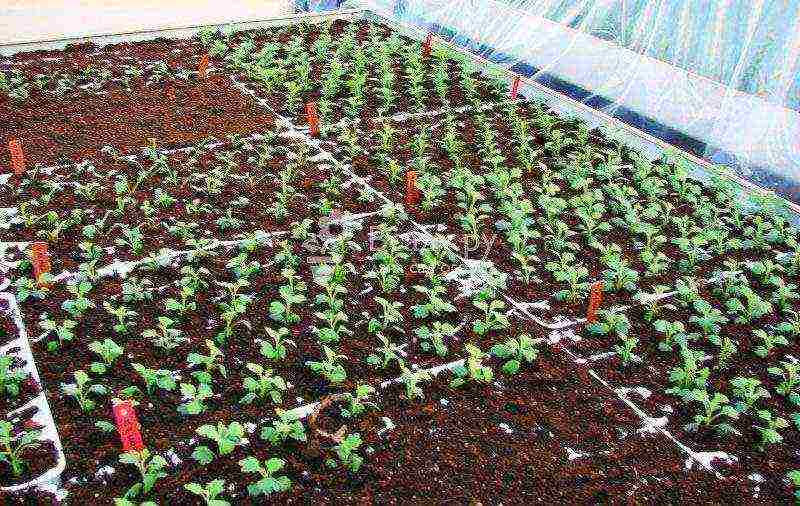

Seedlings of perennial chrysanthemum seeds
Propagation by cuttings
The most popular method of propagation of chrysanthemums, as the cuttings take root quickly and well.


Reproduction of perennial chrysanthemum green cuttings
A shoot 6-7 cm long is cut from an adult plant and rooted in a mixture of peat and sand. After spraying, the container is covered with glass and placed in a cool room, the temperature is maintained at plus 12-15 degrees Celsius. After the roots appear, the cuttings are transplanted into separate pots, and they are transferred to the open ground after the threat of night frosts has passed.


Rooted cuttings of chrysanthemums prepared for transplanting Preparing chrysanthemums for winter
For the abundant flowering of chrysanthemums, planting and care are as important as further preparation for winter. In order for the culture to please you in the next season, you should take measures to shelter it. First of all, the flower should be cut at the very level of the ground, then carefully spud and covered with fallen leaves.
Large-flowered varieties of chrysanthemums do not winter outdoors. They are dug up together with an earthen lump, placed in a pots or box and stored until spring in a room at a temperature of 0 to plus 5 degrees Celsius. Occasionally, an earthen ball should be moistened by spraying or watering.
Digging the rhizomes of large-flowered chrysanthemums for the winter
Autumn transplant
In the fall, chrysanthemums are still blooming in the garden. It is necessary to transplant flowering bushes very carefully, since the slightest damage to the roots can have a detrimental effect on them. Gardeners are still arguing about the autumn transplant of chrysanthemums. Some do not see the point in this, while others, on the contrary, argue that this is how the root system develops better and frost resistance increases.
The process of transplanting chrysanthemums in the fall is practically no different from the spring, but it has its own characteristics:
- Flower bed preparation. While digging the land, apply organic fertilizers - compost or peat. Do not overdo it with the quantity, there should be 500-600 g per 1 sq. m. Otherwise, the plant will increase the deciduous mass to the detriment of its flowering.
- Bush preparation. Cut the roots around the plant in a radius of 20-30 cm with a shovel. This promotes the formation of new roots and helps the chrysanthemum to take root in a new place faster.
- Digging a bush. Water the plant liberally right under the root with water and gently dig up along with a lump of earth.
- Transfer. Since we will plant the bush with a lump of earth, the depth of the holes must be increased to 40 cm. Pour the soil with Kornevin's solution and carefully place the bush with earth in the hole, cover it with earth and tamp it with your palms.
- Water the bush liberally.
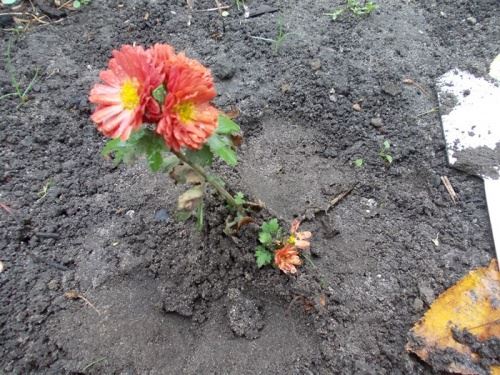

Over time, the soil around the transplanted bush may settle, so it will be necessary to fill up the soil. You also need to look after, that is, you need to water abundantly with water until the onset of frost, weed weeds and carefully loosen the top layer of the earth. In addition, you will need pruning. In small-flowered varieties, you need to pinch the tops, after which the side shoots will begin to actively grow. Thanks to this, the bush will acquire a spherical, lush shape. In large-flowered varieties, on the contrary, side shoots are removed. Before the onset of frost, mulch the soil with sawdust or straw. Also, do not forget to insulate the bushes for the winter.
Chrysanthemum transplant is not a very difficult, but responsible business.When answering the question when it is possible to transplant chrysanthemums, we will answer that this can be done both in autumn and spring. But, of course, it is better to do this in spring - the bushes have more chances to take root and take root in a new place. If transplanted before the onset of winter, there is a risk that the flowering bushes will not have time to adapt in a new place. Do not forget that only winter-hardy varieties are subject to direct transplantation. More heat-loving chrysanthemum species need to be dug up, planted in a pot and removed to the basement.
To ensure the active growth and flowering of chrysanthemums, it is necessary to comply with a certain list of requirements for growing and caring for the crop. It is important to follow the rules of planting, watering, pruning, transplanting a plant, as well as protecting chrysanthemums from pests and diseases.
Outcome
Diverse bushes of chrysanthemums of various colors are in perfect harmony with each other, giving the gardener the right to combine them at his own discretion. Even a small flower bed decorated with these plants will make your site luxurious and you can show off to your guests.
The main autumn flowers are chrysanthemums, planting and caring for these flowers in the open field is not particularly difficult, but they require compliance with a number of conditions when growing, both in spring and in autumn. Do not break the rules if you want to plant a flower from a bouquet or root a shoot, but to propagate a plant in the fall, check out the main points. If you do not know how to form a beautiful bush with a ball, then remember, you need a pinch and pruning for the winter, or try to grow a special variety that will only need a single pinching ...
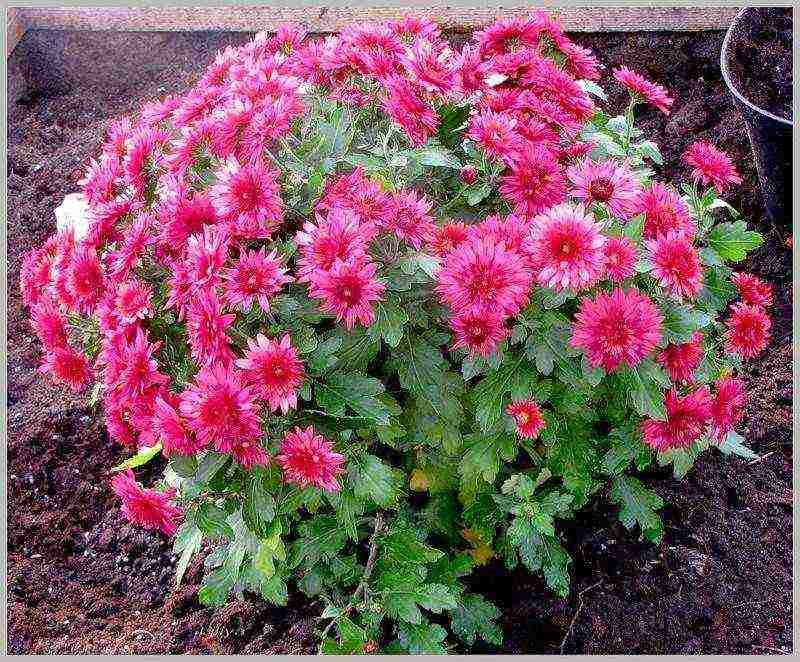

Tips & Tricks
To ensure vigorous growth and flowering of the crop, you should heed the recommendations of experienced gardeners for growing and caring for the plant.
If the bushes have wintered in pots indoors, then they should be prepared before transplanting them into open ground. So that they can get stronger and easily take root in a new place, it is recommended to harden. The pots are taken out into fresh air, and after a week they are transplanted to an open area.
Disembarkation can be carried out at the old place. After 2 weeks, the first feeding is performed.
If the representatives of the variety are tall, it is necessary to prepare a support for them in advance.
In autumn, plants are transplanted into pots while still in flowering bushes. The transplant will be successful if you follow all the recommendations. The culture will quickly take root in a new place, where it will actively bloom with wild colors throughout the season.
Chrysanthemums are popular garden flowers. They bloom in autumn. If the climate permits, they will decorate the garden until winter. These flowers are hardy and completely unpretentious plants. But they still require some care. In this article, we will figure out when to transplant chrysanthemums so as not to harm them.
The choice of planting material in the fall
Autumn planting material is the most convenient in the selection of varieties. At this time, flowering bushes are usually sold in pots or with a closed root system in a film. But here it is necessary to carefully study not the bush itself, but its roots. More precisely - look if there is young growth in the pot or near the central trunk, which speaks of the viability of the chrysanthemum. If not a single sprout breaks out of the peat, it is better not to buy such a plant, since the probability of successful wintering in the ground is almost zero. But there is a chance to keep the bush in the basement.
Fresh articles about garden and vegetable garden
Fertilizing transplanted chrysanthemums
For the full development of the root system, chrysanthemums are fed with fertilizers. Each bush is fertilized. Organic matter saturates the soil best of all. But the positive effect can be enhanced with superphosphate and potassium preparations.
The main thing to remember is that when using chicken manure or compost, they must be diluted with water. The ratio of organic matter to water is one to ten. Otherwise, you can harm the roots of chrysanthemums.
The chrysanthemum you just bought needs to be transplanted into a new pot. Outwardly, the flower may look healthy, but its root system is visible only during transshipment. Sometimes a room chrysanthemum can have damaged or diseased roots, which requires urgent action, otherwise the plant will die.
In the future, the transplantation of room chrysanthemums is carried out on time, as for other plants - every year for young flowers, and chrysanthemums 3 or more years old are transplanted in a year.
The purchased indoor chrysanthemum will be transferred in the next few days, and the plants already growing in your apartment are transplanted in the spring - around March. During this period, the chrysanthemum begins to grow actively, so it takes root much better.
Preparing a place for planting chrysanthemums
Chrysanthemums prefer sunny areas. It is better to break the bed on a hill. In the shade, the plant looks depressed. The flower is sensitive to groundwater. If they are close to the roots, good drainage will be required. River sand can be used as a drainage layer.
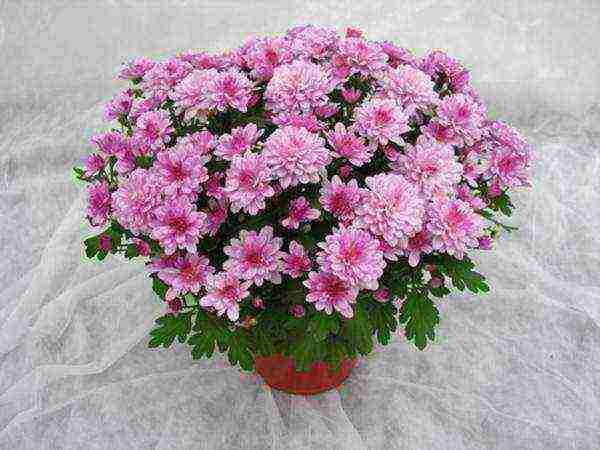

The soil on the site should be loose, preferably neutral or slightly acidic. If the soil for planting is too heavy, then it is enriched with peat, humus and rotted manure. No more than 0.5 kg of fertilizer is added to each hole, otherwise the plant will have a good crown next year, but flowering will be poor.
How to replant in spring
You can transplant the culture at the end of the winter period, after the snow has melted. In this case, the plant will have time to get stronger by winter and calmly endure the cold.
Choosing a site for a flower bed
The culture feels comfortable in flower beds that are well lit by the sun's rays. Should not be close to the groundwater surface. If they run shallow, then coarse sand is added to the holes.
Preparing bushes
The plant is carefully dug out without damaging the roots. If the soil is dry, it needs to be moistened enough to easily remove the crop.
Dividing the bush
Each sprout is separated from the uterine root with a sharp knife. Each part must have roots with shoots.
Transfer
An undivided bush or parts of it are planted in separate holes, at a distance of 25 centimeters from each other. The pits should be pre-prepared in the fall. Humus mixed with garden soil is introduced into each hole. The pits are 20 centimeters deep.
Watering
To root the culture after transplanting, it is necessary to water it frequently. You also need to ensure that there is no stagnation of water. With the active growth of shoots, harmful insects can attack. Therefore, you should periodically inspect the bushes in order to identify pests or diseases in time.
How to prepare a planting pit for a chrysanthemum in the fall
The depth of the planting hole for chrysanthemum does not exceed 40 cm. Each hole is well drained, fertilized and watered. The bush is lowered into a hole, practically without deepening it. After planting tall varieties, a support is installed. Seedlings need to be pinched, which is carried out immediately after planting. In hot autumn, the plant is shaded for a week from sunlight. Chrysanthemum rooting is slow. If there are difficulties with the autumn planting of chrysanthemums in the ground, then you can plant a seedling in a container. Choose a shallow but spacious drawer. The root system of the plant lies closer to the soil surface and does not require significant deepening. Shrub shoots are cut 2/3 of the height. Pots with seedlings are stored in the basement, where the temperature does not exceed +6 degrees. During the entire storage period, it will be necessary to occasionally water the plant, preventing the dryness of the earthen coma.
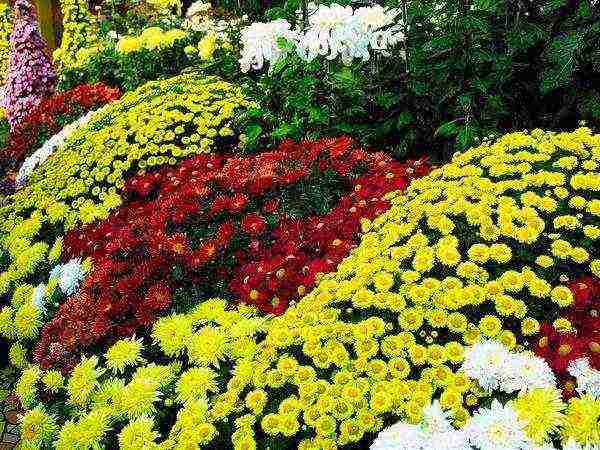

Chrysanthemum in a pot: care after purchase
The first thing to look for after purchasing a flower is lighting and temperature. Homemade chrysanthemums are recommended to be placed on the west or east window.Another option is to put the flower on the balcony, which is well lit and, if there is a loggia, is regularly ventilated.
Caring for a potted chrysanthemum after purchase also presupposes compliance with the following conditions. Recommended temperature regime for growing a flower: 20-23 degrees in summer, 15-18 in autumn and 3-8 in winter. Chrysanthemum tolerates hot summer well, provided that it is in a shaded, ventilated room. The plant is also able to withstand short-term frosts down to -3 degrees.
Note! The culture prefers short daylight hours (8-10 hours) and cool weather. These conditions are fully consistent with the autumn season.
As for watering, it should be regular, abundant, but no frills. You do not need to fill the plant. The soil is moistened after the top layer has dried. Chrysanthemum feels comfortable in high humidity. Therefore, it is recommended to regularly spray the plant with water, and it is not difficult to care for it.
Chrysanthemum bush division
Chrysanthemums reproduce very well by dividing the bush. Moreover, the bush must be divided every 2-3 years, otherwise the flowers of the thickened bush become smaller, and diseases develop more often. And one day in spring you will find that the mother bush has disappeared, and this can happen even in a not very harsh winter. On the periphery of the bush, one or several undergrowth sprouts can survive, and its center turns out to be bare. And there is only one reason for the death of the bush - there was no regular spring planting of numerous chrysanthemum shoots.
Therefore, in the spring, when the return frosts end, you need to carefully dig out the bush and free it a little from the ground.
Then, with a sharp pruner, divide the young growth, immediately plant the shoots with roots in the garden at intervals of 35x35 cm or 40x40 cm and water. You can put it on the same place, you can put it on another, but you need to plant it a little deeper.
The soil around the plants must be well compacted, otherwise there will be strong shoot growth and weak flowering. In the first days after planting the shoots, they must be watered abundantly.
By the beginning of autumn flowering, a lush, magnificently flowering bush is formed from each such shoot.
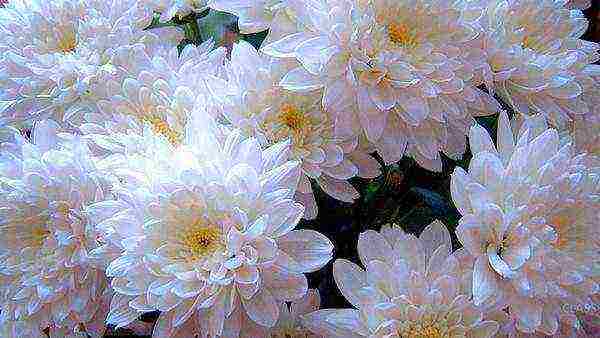

Transplant and reproduction
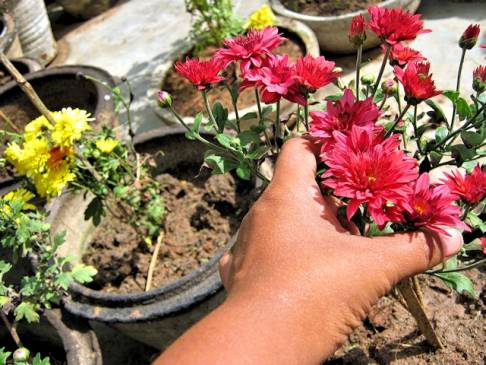

A little effort, and a beautiful chrysanthemum will appear in the house
When the root of a young shoot no longer fits in the pot, the plant must be transplanted. For an adult chrysanthemum, the soil mixture is prepared from the following components:
- handfuls of bone meal;
- 3 parts of garden soil;
- 1 part sand;
- 0.5 parts of dry manure;
- 1 part peat.
The process has the following features:
- Transplant the plant into a larger pot.
- As with grafting, drainage is used.
- The day before the proposed transplant, the land is watered.
- A young flower needs support. When the stems get stronger, you can refuse it.
- If after a certain time roots appear on the surface of the soil, the chrysanthemum should be transplanted again. Otherwise, this procedure is not necessary. Although some breeders advise replanting a young crop annually, and adult flowers after 2-3 years.
Chrysanthemum is propagated in three ways:
- using seeds;
- cuttings;
- dividing the bush.
If you prefer to propagate a flower by planting seeds, you need to do the following:
- Fill the prepared container with drainage, then with soil mixture.
- Place the seeds to a depth of 1 cm. The chrysanthemum planting material is left on the surface.
- After two weeks, sprouts will appear.
- The soil must be constantly kept moist. The temperature should be up to 18 ° C.
- When several leaves appear, the culture is planted in separate pots.
To propagate the plant by dividing the bush, you need to remove the chrysanthemum from the soil in the spring and cut the root in half. Separate parts are planted in the soil at intervals of 35x35 cm.The composition of the soil mixture should include sand, humus and turf soil (in equal proportions).
Important! Once every two to three years, it is necessary to divide the main chrysanthemum bush.
Cutting method. A distinctive feature of this breeding method is that the procedure must be carried out in warm weather, when the temperature rises to 22 ° C-26 ° C. The process has the following features:
- Initially, you need to make the lower cut under the internode, and the upper cut 3 mm above the leaf with the bud.
- Prepare seedling containers. Nutrient soil is poured into them (composition: sod land, river sand, peat in equal proportions). You can add a handful of bone meal or dry manure. Sand is poured on top, in a layer of 2 cm.
- Select stems 15-20 cm high and cut off the tops of the shoots that grow from their base. Remove the bottom leaves.
- Dip the cutting into a special growth stimulant powder. They are sold in garden stores.
- Stick the cuttings into a damp spotting box so that a slight slope forms. Expect them to take root.
Important! Deepen the stalk no more than 1.5 cm. It should only touch the sand layer.
Chrysanthemums leaving in autumn
Care for fading chrysanthemums is as follows. With the arrival of the first frost, they are cut at a level of 12-15 cm from the ground. Then they spud and lay a layer of mulch with a thickness of about 35 cm.It is better to choose dry foliage as a material. If severe frosts are expected in winter, then it would be wise to make additional shelter from spruce branches.
Many thermophilic varieties will not be able to winter outdoors, so they are dug up in the fall. Such bushes, along with a lump of earth, are placed in wooden boxes or separate containers and stored in a cool place. Sunlight must be in the room, the air temperature is required + 3–6 ° C. Periodically, a clod of earth needs to be moistened. Landing in open ground can be done in May, when the weather becomes consistently warm.
How to transplant in the fall
Autumn transplantation is performed during the flowering of the bushes. It is desirable that the day is cool and not sunny.
Important: during autumn planting, the most favorable conditions for the culture are created so that it has time to take root before the onset of cold weather.
Flower bed preparation
The soil for transplanting is prepared in advance. Layers in the hole:
Since the roots grow parallel to the soil, they should not be buried. For tall varieties, additional support is placed.
Bush preparation
The preparation of the plant for transplantation can begin before the onset of frost. At this time, the roots are cut with a shovel around the crop within a radius of 25 centimeters. This promotes the formation of young roots, which makes it possible for the bush to quickly take root in a new place.
Digging a bush
Moisten the soil around the plant with plenty of water before digging. Then the bush is taken out with a large clod of earth, carefully so as not to damage the roots.
Open ground transplant
The size of the plant pit should be larger than necessary. This is done so that a plant with a dug out lump of earth will enter the hole. The depth of the pit is 35-40 centimeters. For rapid growth and development of the root, it is recommended to add a biostimulant to the soil.
After that, the bush is placed in a hole and covered with soil. From above, you can tamp with your palms. After transplanting the culture, it is recommended to cut off all the flowers so that the bush does not waste its nutrients on them.
Watering
During transplantation, the culture should be watered abundantly. If the weather is dry all the time, then after 2-3 days the plant needs to be watered again.
It is important to ensure that the soil is always moist and does not dry out, since during the rooting period the plant needs a sufficient amount of moisture and nutrients.
Feeding chrysanthemums in autumn
Top dressing is necessary for plants throughout the season.In summer - 6 weeks after planting and caring for chrysanthemums, in autumn - during budding. The first top dressing is carried out with complex fertilizers with a predominance of nitrogen, so that the flower quickly gains a green mass, then potassium-phosphorus compositions are added. Chrysanthemum roots are sensitive, so solutions should be applied after watering or rain.


Tips and tricks from experienced florists and gardeners
Chrysanthemums that have wintered indoors should not be planted in open ground without prior preparation. They need a little time to get stronger and adapt to new conditions. Flowers need hardening - for this, the plants are taken out into the street in pots and only after 7-10 days are planted in the garden.
After wintering, it is allowed to plant the chrysanthemum in the old place, since over the past time the soil has had time to "rest". The wells are pre-filled with ash mixed with earth. Plants need regular watering. You can feed the flower 2 weeks after its "resettlement" in the open ground. If it is assumed that the plant will be tall, it is necessary to establish a support for it in advance, otherwise, at the slightest breath of wind, the chrysanthemum may break.
Thus, observing all the recommendations listed in the article, the transplant procedure will be successful: the plant will quickly take root in a new place and will actively develop and bloom throughout the season.
Reproduction of chrysanthemums by cuttings in autumn
It is recommended to propagate chrysanthemums by cuttings (cuttings) from late February to early June. Cutting is the most reliable and productive way of chrysanthemum propagation.
Cuttings - Plants for propagation in the fall are cut low and dug up and stored in a dark and cool room. The temperature in this room should be within 6-8 degrees Celsius. The dug out plants are covered with sand. In this state, the plants are stored until the end of February, periodically watering.
At the end of February, the bushes are transferred to a room with an average temperature of 15 degrees Celsius and planted in pots with fertile soil. The recommended composition of the soil is as follows: humus, leaf or garden soil and sand, in a ratio of 2: 3: 1.
The planted plants are watered and, after 1 week, fed with a solution of ammonium nitrate, using 20 grams of nitrate per 10 liters of water. In the room where the chrysanthemums are planted, it is recommended to install the backlight so that the light falls on the plants not from the side, but from above. Thanks to the stimulation, the chrysanthemums will begin to grow vigorously. Then proceed directly to grafting.
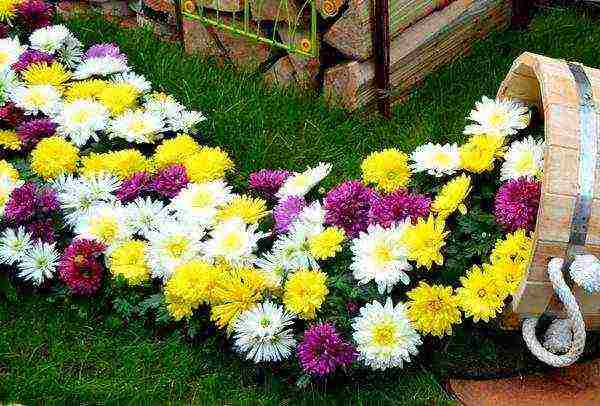

Chrysanthemum care tips
- If the plant does not have enough light, the buds do not open.
- Excessive sunlight will lead to fading and wilting of the leaves. This can also happen due to poor watering. In especially advanced cases, the leaves fall off.
- At high temperatures (more than 25 ° C), the Chrysanthemum blooms rather poorly, the buds, if they bloom, wither very quickly, fall off. If overheating is accompanied by a lack of ventilation, the plant sheds both buds and leaves.
- Chrysanthemum has a weak resistance to fungal diseases. If the agrotechnical principles of cultivation are violated, the stems are deformed, the leaves become discolored. If this happens, you will have to get rid of the plant; it cannot be reanimated.
- In some cases, the presence of insect pests on the Chrysanthemum is possible. Most often it is aphid. To destroy it, the plant is watered with a soapy water solution once every 7 days. In addition to aphids, spider mites can settle on a flower. Controlling these pests is using it to treat pyrethrum. A tincture of chopped garlic in water also helps. Without a doubt, an effective fight can be carried out with store-bought pesticides, however, one should be careful with the chemicals used and accurately observe the dosage.
Pruning chrysanthemums in the fall
Not all growers believe that chrysanthemums must be cut before wintering. Many people think this is superfluous, but some still practice. The point of pruning is that shortened stems require fewer resources for their vital functions. It turns out that, thus, the roots of the plant, as it were, retain their strength, therefore they successfully winter. But this is not always the case. Pruning is not a guarantee that chrysanthemums will survive until spring.
Another advantage of pruning is that shortened branches are easier to cover for the winter. They do not need to be bent down and somehow arranged.
When to transplant chrysanthemums
In one place, a shrub can grow up to 2-3 years. After this time, the chrysanthemum must be transplanted. If you do not follow this procedure, the bush will begin to ache, the flower baskets will begin to shrink and eventually flowering will stop completely. And, of course, many are interested in the question of when it is best to transplant a plant so as not to cause severe harm to it.
The most favorable time for a chrysanthemum transplant is spring. In the fall, the bushes need to be dug up together with a lump of earth, planted in a pot and removed to a dry basement for the winter. However, winter-hardy varieties of flowers can be replanted in the fall. This is best done in late September and early October. An ideal day for planting is a cloudy or slightly rainy day.
Why is it necessary to transplant the plant in the spring? The fact is that for culture, relocation from one place to another is a great stress. If this is done in the fall, there is a high probability that the chrysanthemum will not have time to get strong enough before the cold weather and will not survive in the winter.


Another important point is the simplicity of the work. In the spring, after the snow melts, the ground is moist and pliable, which makes it much easier to dig the bush. At the same time, the risk of injury to the roots is minimized, while it is much more difficult to remove the bush from the frozen soil.
The time for planting depends on the climatic conditions of the region. The resettlement should be started when the weather is warm enough and the threat of frost has passed - around the end of April or the beginning of May. It is necessary to transplant again in cloudy weather or in the evening.
Next, we will consider the features of spring and autumn chrysanthemum transplantation.
Nice place for flowers
Planting a chrysanthemum in the fall is important in a place where it could take root in the shortest possible time. In the case of this flower, this is a dry, sunny place. Chrysanthemums do not tolerate shade and a lot of moisture, so it is better to plant them on some elevation. As a rule, in such places there is no thick shade, and a small breeze blows through the ground, which removes excess moisture.


We plant chrysanthemums in the fall in loose soil that allows moisture and air to pass through well. This will provide the plant with rapid growth and abundant flowering. Do not forget about the nutritional value of the soil. The more organic matter and minerals it contains, the better. If the soil in your garden is not at all like that, then you can improve its qualities yourself. To do this, season the soil with rotted manure, add peat or compost to it. You can also mix the soil in which you will plant the flower with sand. This will improve its drainage properties.
Date of publication: Landing in open ground
Preparing for landing
If you decide to plant a lovely chrysanthemum in a pot, you will need to take into account a number of key features so that the flower grows safely in the apartment. Let's consider each aspect in more detail.
Seat selection
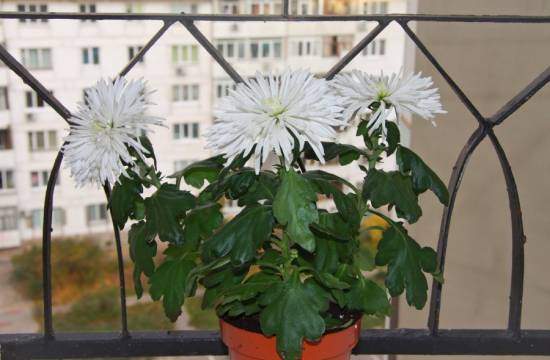

Chrysanthemum loves a shaded and warm place
You need to choose a suitable place for a flower taking into account the following factors:
- In order for a chrysanthemum to feel comfortable, it must be in certain temperature conditions. The best place for her would be a window sill on the east or west side of the house.
- The plant should not be placed in a northern direction, since this will adversely affect its development. The chrysanthemum may not even bloom.
- In the summer, the temperature in the room where the flower culture grows should be between 20 ° C-24 ° C.
- With the onset of autumn, their level should be lowered to 15 ° C-18 ° C. You should not exceed the temperature.
- You should also take care of the lighting. Flowering depends on this. Chrysanthemum prefers short daylight hours, prolonged exposure to ultraviolet radiation is highly undesirable for it. It is enough for the plant to receive the sun's rays for eight hours, after which the culture should be covered with a paper cap.
In an overly warm room, the flower buds dry up and the leaves turn yellow.
Soil preparation
The soil for the chrysanthemum should be loose, neutral and rich in nutrients. To prepare you will need:
- sand;
- humus;
- sod land.
All components are mixed in equal proportions until a homogeneous mass is formed. Bird droppings can be added to increase the nutrient content of the soil mix.
Do not use acidic soil for growing crops.
Features of planting in the fall
Can chrysanthemums be planted in autumn? Despite the fact that it is already cold in autumn, and winter frosts are ahead, flower growers are often inclined to believe that chrysanthemums can be planted at this time. They explain this position by several factors.
Autumn planting of chrysanthemums is good because the variety of flowers is clearly visible at that time. The height of the bushes and other characteristics of the plant are also clearly distinguishable. When buying a flower, you will know exactly what to plant. In the spring, you have to take the seller's word for it, because you cannot determine either the characteristic sizes or the colors of the seedlings.
In the fall, you can pick up early and late varieties. By planting them in a beautiful sequence, you will prolong the blooming appearance of your flower bed.
However, landing at such a time has its drawbacks. The plant may not have time to properly root before the onset of cold weather. This will lead to his death. Therefore, during autumn planting, you need to create the maximum of good conditions for the flower.
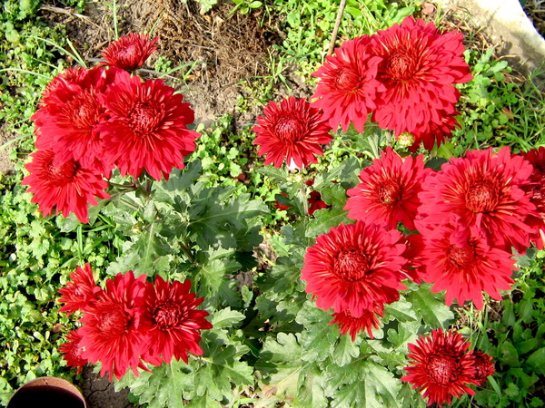

When is the best time to plant chrysanthemums in spring or autumn? This question can be answered unambiguously. It is better to plant even perennial flowers in spring. Until the winter cold, such a plant will take root well and will easily survive until next spring. He'll just have more time for it. But if suddenly you really wanted a chrysanthemum, and it's autumn outside, it doesn't matter either. Plant it boldly. Just remember not to do this in October and November. It is too late, most likely the flower planted at this time will die. September is the right month. At this time, it is still warm outside, and the moisture does not exceed favorable indicators. Planting chrysanthemums in the fall in the Moscow region is carried out based on the same considerations.
By the way, if you are afraid to plant chrysanthemums in the fall, you can not do this. Store rooted cuttings in the cellar until spring. The main thing to remember is that it should not be colder than 5 degrees Celsius in the basement. It is also important to keep it dry. Plants can rot very quickly from dampness.
If it's already deep October outside, and you have chrysanthemum cuttings in your hands, and you really want to plant them, then do it. Just land not in the ground, but in a pot. In the spring, you will plant the plant outside. The disadvantage of this method is that the plant will not rest over the winter.
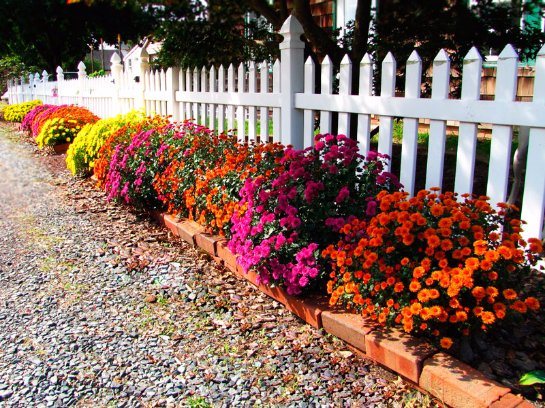

Plant decoration
For the formation of a bush of the correct shape and the formation of flowers, it is correlated with varietal characteristics, the tops of the central buds and lateral shoots of plants must be pinched in a timely manner.
For large-flowered varieties - pinch the top of the central shoot with the appearance of 8 leaves, after which lateral shoots develop, of which 2-3 strong ones are left, and the rest are removed. Grasshopping is carried out as needed 1-2 times a week to form one large flower on each stem.
For small-flowered plants - the top is pinched with the appearance of 4-6 leaves, after which new shoots are formed, the pinching of which is carried out in the presence of 8 or more leaves. After re-pinching, many new shoots appear, as a result of which the chrysanthemum bush acquires splendor.
Periodic pinching affects not only the formation of the bush, but also the development of the plant as a whole, since the stepsons only draw a large amount of nutrients from the bush.
Thus, the reproduction of chrysanthemums can be done not only in the presence of a bush growing in the garden, but also from a donated bouquet, and the whole process is shown more clearly in the video - the reproduction of chrysanthemums.
Chrysanthemum on the site is a riot of colors, an abundance of flowering and a variety of forms. Growing this plant in the open field in the country, it blooms in August and pleases all autumn, even small frosts are not afraid of it.
How to choose cuttings for planting?
The autumn planting of chrysanthemums carries risks, so cuttings for it need to be chosen the most viable. In particular, they should be:
- Not blooming. Plants with buds take root very poorly. A lot of resources are taken by the flowering part, so very few of them remain for rooting. As a result, the plant fades and after a while it is likely to die.
- The cuttings should have root shoots. Their presence increases the likelihood of favorable rooting and successful wintering.
- The root of the flowers should be well defined. The quality and speed of rooting depends on its size.
Also, be sure to pay attention to the appearance of the plants. Cuttings of flowers should look healthy. They must have a characteristic color. If you decide to purchase seedlings over the Internet, then before accessing any site, read reviews about it. It is important to understand that the better you select the cuttings, the better and faster they will be accepted. This is especially necessary in the autumn.
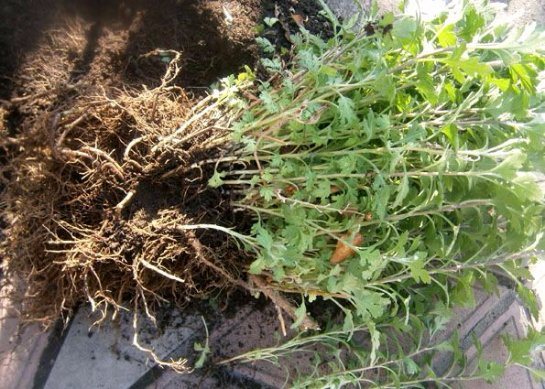

Shrub chrysanthemum: combination with other plants
Perennial garden culture goes well with fruit trees (it can be rowan or wild apple). A good combination is given by raspberries growing nearby, sea buckthorn, barberry. Shrub chrysanthemum looks incredibly attractive in the company of decorative leafy plants - hydrangea, ivy, wild grapes, lemongrass. The chrysanthemum looks charming and gentle surrounded by tall perennial plants: dahlia, shrub aster, asparagus and other plants.
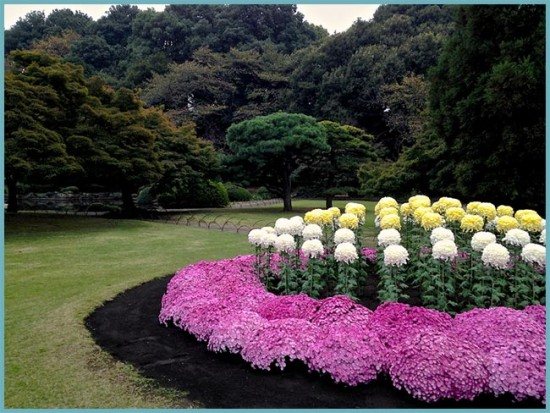

Shelter for the winter
Before the onset of frost, plants need to be prepared, especially those grown in greenhouses. During the growing season, these chrysanthemums completely "eat up" the soil in the pot, the roots are woven into a solid ball, which cannot be straightened out during planting. Such specimens will freeze out without shelter, even if shoots, indicating rooting, appear. Usually 1-2 layers of non-woven covering material are used. The folk method is also suitable: put spruce branches on the bushes, and cover it with mature humus on top.
Lapnik is the best natural covering material for plants
In the northern regions, it is better to grow even Korean chrysanthemums in pots, and carry them to the basement for the winter. If you run the risk of leaving them in the garden, it is advisable to carry out cuttings in order to surely preserve the variety.
And in my lifetime there have been winter losses of greenhouse chrysanthemum balls, bought and planted at the end of October. Of course, I didn't cover them. In the spring, she pulled the frozen black stems out of the ground. Now I do not risk it and never plant copies "on one leg" in the fall. I cut them off, leaving 5 cm stumps, plant them in pots and put them in the cellar, water them occasionally. I plant it in the garden in the spring. In September, after flowering, I cut it off, dig it out, if possible, I divide the bush in half and put it in a new place in fertilized soil. I water it twice with the rooting plant. Before frost, I cover it with lutrasil.Thus, zoned and multiplied chrysanthemums overwinter perfectly. I especially liked the Korean variety. The bush grows rapidly, the reddish-gold flowers change color several times.
The Koreyanka variety, with shelter, tolerates cold winters in the open field.
How to plant (transplant) chrysanthemum correctly
In the spring, when last year's bushes grow back after wintering, I dig them out, pour the soil from the roots (if the soil is sandy) or wash it off with water. Then I separate each sprout so that it has independent roots.
Note that green sprouts of chrysanthemums tend to form roots. For this, it is necessary that the soil in which the green cuttings without roots are planted is constantly moist until the shoots take root. Therefore, if you have little planting material, you can use all the shoots from the bush when planting chrysanthemums, even those that have broken off or were left without roots.
In addition, you can plant chrysanthemums with green cuttings. When the transplanted (transplanted) chrysanthemums take over and begin to grow, you can break off the green cuttings (stepchildren) and root them. You can also root green cuttings from chrysanthemums pinched during planting, if at the time of planting the sprout has 7-8 true leaves.
Break off the top, which has 3-4 true leaves. Plant the resulting green stalk (just stick it) into moist soil so that the soil fits snugly against the stalk. Remove the lower pair of leaves from the cutting and plant the cutting so that the lower node is deepened.
In the early days, planted chrysanthemum cuttings should be shaded or a damp cloth should be thrown over them. The soil must be kept moist at all times until rooting. Rooting of cuttings takes place within two weeks.
Growing problems
If hoya and decorative chrysanthemums in a pot turn yellow, dry and wither, then this fact indicates the presence of diseases, or improper care.
For example, the soil was overdried or, on the contrary, flooded. Therefore, the first step in case of problems with chrysanthemum, if it has dropped the leaves, its soil needs to be replaced. Next, you should pay attention to its illumination, for example, due to insufficient light, the bush began to disappear and does not bloom. Therefore, if in the fall the bush did not give flowers, then you need to reconsider the care for it and the conditions of detention.
For example, the intensity of light rays during the day is at least 10 hours. Top dressing includes potassium and phosphorus, and the plant should not be nipped late. Sometimes it happens that the chrysanthemums in the pots have dried up and only the twigs have partially begun to die off. The first thing to start with the resuscitation of the bush is to remove all dead wood and examine the ground. Perhaps the flower was poorly watered, or pathogenic bacteria multiply in the soil, which infected the entire bush.
In addition to microorganisms, domestic chrysanthemums can infect some harmful insects. For example, a spider mite is very often found on the leaves, which affects the surface of the green crown. In the fight against it, a weak soap solution is used, after which the flower is washed with warm water. Powdery mildew is another common problem, which appears as a gray coating on the leaves. A solution with a fungicide will help to deal with such a nuisance. In addition, chrysanthemums in pots are very often affected by gray rot and septoria. Rot is manifested by a gray, fluffy bloom on the leaves, and is also removed by foundation. Septoria leaves red spots on the leaves, you can fight it with the help of the above drug.
In the fall, flower shops offer a variety of flowers for sale. Including chrysanthemums is no exception, since it is an autumn flower and it blooms only at this time. They are very often given and bought already cut, but few people know that these flowers can be grown at home.And in the springtime, some varieties can be planted in the country and enjoy their smell and flowering in autumn.
Chrysanthemum is a plant with abundant flowering shrubs and small-flowered or large-flowered buds that bloom in autumn. There are a very large number of flower varieties, but not every species can be grown at home.
Home chrysanthemums love cool temperatures and short sunny days. It is less capricious and does not need to be placed on a windowsill or balcony. From the plentiful heat over 18 degrees and direct sunlight, the cultivation of chrysanthemums in pots is overshadowed by a short flowering period, drying of the buds.
Potted chrysanthemums love moisture, so the soil and root system should not be allowed to dry out. If you do not water the indoor flower, then it will die, but you do not need to fill it either.
Chrysanthemum zemble refers to a perennial plant that thrives both at home and outdoors in a normal environment. She begins to bloom in early September in large buds and pleases with different colors. It is believed that the zemble chrysanthemum is a loner, more than 1 bud is formed on the stem, and the length reaches 12 centimeters in diameter. And after cutting, the flowers in the vase can stand up to three weeks.
The zemble chrysanthemum is of different types:
- zembla lilak;
- earthbla white;
- zemble lime;
- zembla vip;
- earthbla purple.
Chrysanthemum deco. The homeland of such a flower is Japan. The inhabitants of this country consider this flower a symbol of their country and believe that the morning dew at the flower is the elixir of youth.
White chrysanthemum deco bouquets are a big competitor to white roses and are sometimes used for bridal bouquets. Because they are just like a compliment to innocence and purity.
It can also be grown in a summer cottage in a permanent place as perennial flowers, wrapping them warmer for the winter.
Not only deco chrysanthemums require the same care, but as indoor chrysanthemums, but also mix chrysanthemums, with proper care, will rejoice with their mix buds in the autumn season, like a ray of summer light.
How to plant chrysanthemums in the fall - transplanting, dividing, grafting, leaving.
Chrysanthemum is a beautiful autumn flower that looks very impressive in autumn flower beds. However, this plant is not for lazy people. The chrysanthemum needs to be watered, fed regularly, and preferably shaped if you want it to grow into a fluffy ball. It is demanding on the place of cultivation, and it also needs to be often divided or renewed by cuttings.
These plants can seem moody. Some people don't like the fact that some varieties of chrysanthemums are supposed to be dug up for the winter. And yet they take their rightful place, since they bloom when many others have long withered.


All these difficulties do not prevent flower lovers from planting chrysanthemums in the fall and creating magnificent autumn flower beds with different varieties of chrysanthemums. They have different colors, shapes and create bright spots in the summer cottage. Perhaps the easiest way to grow these flowers is to transplant chrysanthemums in the fall. This happens literally in two steps.
If you purchased a chrysanthemum bush in the fall, then you can evaluate the color and size of the flowers. However, flowering plants do not take root well. Therefore, they need to be transplanted after all the buds have wilted.
Planting chrysanthemums in late autumn is prohibited. They just won't have time to take root. Which will lead to their death during the winter.
Only those bushes on which several basal shoots have formed are allowed to transplant chrysanthemums in the fall. This will ensure the success of the rooting of these plants.
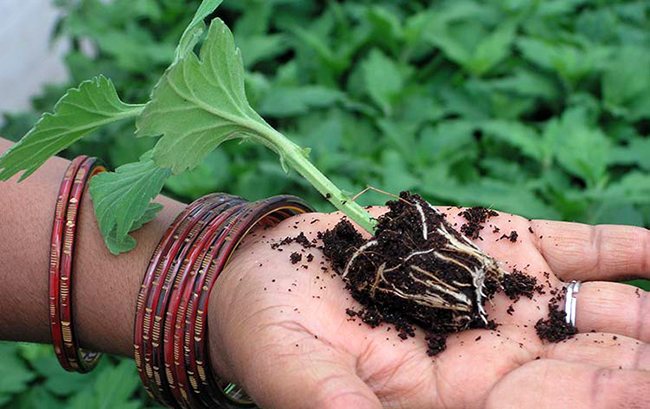

Chrysanthemums description
Chrysanthemums (lat.Chrysanthemum) are a genus of annual and perennial herbaceous plants of the Asteraceae family, or Compositae. Plants are close to the genera Yarrow and Tansy, where many species of chrysanthemums often move.
The homeland of chrysanthemums are the countries of the temperate and northern zones of the Earth, but the largest number of plants still grow in Asia, Europe and Africa.
Chrysanthemums grow mainly in the form of branched dwarf shrubs, less often in the form of herbaceous plants. The height of the bushes is from 50 cm to 1.5 m. The leaves are arranged in regular order, simple, whole, serrated, notched or dissected, different in size and shape, pubescent or not, mostly light green. The flowers are small, collected in a basket, in some species large, consisting, as a rule, of median tubular yellow flowers and ligulate marginal flowers, variously colored and usually arranged in one row. In many hybrid varieties, they are arranged in multiple rows and form the so-called "double" inflorescence. Shoots - naked / or pubescent. Fruit - achene
The culture of decorative garden chrysanthemums has a thousand-year history. In China, where most of the chrysanthemums come from, garden forms began to be cultivated as early as 551 BC. e. Then chrysanthemums were brought to Japan, where they became the national flower. Plants came to Europe in the 17th century, to Russia in the middle of the 19th century.
Some types of chrysanthemums can be successfully grown in the conditions of the SND countries in the open air, others - only in greenhouses, but all of them are appreciated by flower growers for the brightness of colors, long flowering, ease of reproduction.
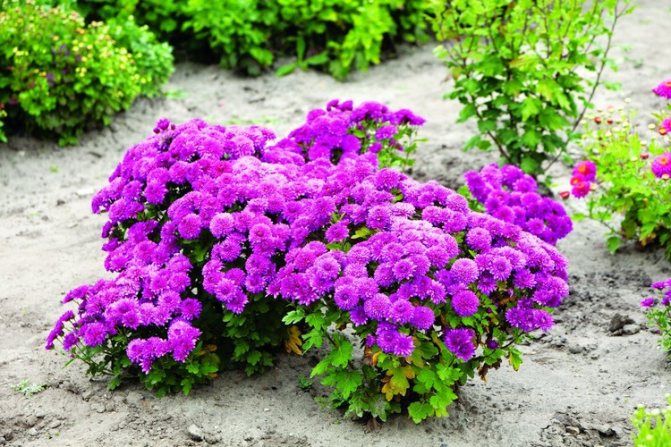

How to divide chrysanthemums
Chrysanthemums are usually propagated by cuttings, dividing the bush or separating young growth from the mother bush. There are two periods when chrysanthemums can be divided. It:
The process of dividing chrysanthemums is very simple. Dig up the bush, divide it into pieces and plant it immediately on the prepared bed.


Chrysanthemum cuttings. Cut the shoots from a bush 7-10 cm long in the fall and plant them in perlite or washed river sand, poured into a seedling container with a layer of 3-4 cm. In a few days you will have rooted plants.
Preparation
Chrysanthemum preparation for transplant assumes the following actions:
- choice of location;
- preparation of planting material.
For transplanting chrysanthemums, choose an area protected from the wind (for example, near the wall of a house) and illuminated by the sun for up to 5 hours a day. Loose, fertile soil with neutral acidity is ideal for the plant. The heavy soil is fertilized with humus and dug up, with the passage of high groundwater, sand is poured into each hole. The transplant is carried out in cloudy, cool weather. Chrysanthemum is a moisture-loving plant, but it does not tolerate low areas with stagnant water.
Plants purchased in the summer from the store in a pot should be transplanted as soon as possible after purchase, since they are sold using temporary soil with a short duration. The seedling is carefully removed from the pot, the roots are washed, and they are examined for mold and rot. To prevent fungal diseases, the roots are kept in a fungicide solution for 30 minutes.
Home seedlings in cups a week before transplanting, they begin to harden, taking them to the balcony or plot for the day, and at night they are transferred back to the room. 3 days before the expected day of planting, the seedlings are left on the site overnight. The soil in the cups is kept moist.
shop plants
home seedlings
For transplanting a perennial chrysanthemum to another place, a sunny site is selected, located on an elevation and protected from the wind.
Before digging, the plant is watered abundantly, so that when it is removed from the ground, it will less injure the roots, and leave until the next day to better soften the soil.
When to plant (plant) chrysanthemums
As a rule, I plant chrysanthemums from the second decade of May to early June. For planting, I prepare shallow holes at a distance of about 30 cm from each other. If chrysanthemums are planted by a plantation, then I leave a gap of about 50 cm between the rows.I fill the wells with water and plant the prepared sprouts of chrysanthemums in them. This applies to both small-celled and large-flowered varieties.
During the transplantation (planting) of chrysanthemums, I pinch the tops of the sprouts over the 4th or 5th real leaf (of course, if the sprout has reached the appropriate size by the time of planting). Pinching the tops of the seedlings is necessary in order to stimulate the growth of stepchildren from the leaf axils. Thus, if the tip is pinched over the 4th leaf, four stepsons will appear on the sprout - these will be first-order shoots.
On small-flowered varieties of chrysanthemums, this procedure will need to be done after a while and with the stepchildren, when they reach the appropriate age, that is, pinch over the 4th or 5th leaf. After such a pinching, stepchildren also begin to grow on the stepchildren - shoots of the second order. This creates a very lush bush with many buds. You can pinch a third time, but I get by with two.
Chrysanthemum on the site is a riot of colors, an abundance of flowering and a variety of forms. Growing this plant in the open field in the country, it blooms in August and pleases all autumn, even small frosts are not afraid of it.
Chrysanthemums: varieties and varieties
It is not in vain that they say about perennial chrysanthemums that they inspire optimism in a convinced pessimist. After all, these lush and fragrant flowering plants can make bright not only a personal plot, but also the life of a gardener who grows picturesque plants and horticultural crops.


Every time you buy a bag of an unknown variety, you are amazed at the duration of its flowering, the magnificent colors, the height of the plant, the shape and texture of the petals, as well as the degree of their doubleness.
Breeders divide chrysanthemums into:
There is also a gradation in color, flowering periods, flower size and decorativeness. Many subspecies of chrysanthemums are intended only for subsequent cutting and making bouquets - these are the so-called bouquet chrysanthemums. Their height can vary from 15 to 150 cm. Such a wide range allows you to decorate entire flower beds with a variety of cultures, which will bloom and delight the eye at different times - from mid-June to the first snowfall.


As for the color of the buds, it is impossible to immediately list all the colors and shades. There is an unthinkable number of colors that excite the imagination: white and lemon, orange and purple, crimson red, lilac and emerald.
The historical homeland of chrysanthemums is Northern China, where residents were actively engaged in the selection of this amazing and, fortunately, unpretentious garden culture. Thanks to the merits of professional breeders, today it is possible to grow chic varieties of perennial chrysanthemum with excellent consumer properties.
The most widespread and well-known variety - "Early Yellow" is close in decorativeness to Japanese anemones. Today there are about 700 varieties of these garden plants.
- Very popular bush chrysanthemums, which are equally suitable for arranging the landscape of the garden, and for cutting.
Plant propagation
Breeders recommend propagating a perennial crop only by cuttings and dividing the bush, since the seeds often do not preserve the variety.
Attention! Reproduction is best done in late spring (in May), when the probability of frost is minimal. The beginning of summer is also a good period for replanting the plant.
If you only have material for planting closer to autumn, then have time to plant it by mid-September so that the first frosts do not break the spirit of the plant. Otherwise, the seedling can be transplanted into a wide, but (very important!) Shallow pot, having previously cut it low.
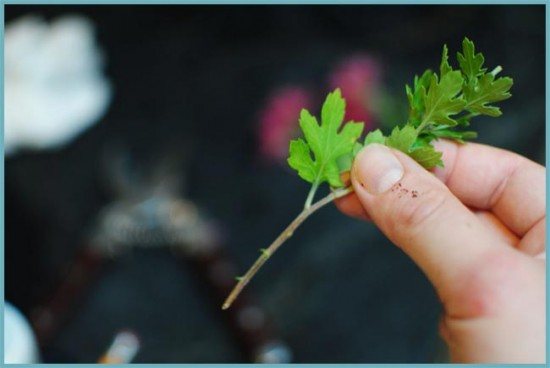

The container with the planted chrysanthemums is placed in a dark place (it can be a loggia or a terrace), where the temperature is kept at a constant level of 4-6 ° C.Throughout the winter period, it is necessary to maintain an optimal level of soil moisture.
At the end of winter, the bushes can be planted in a greenhouse or flower greenhouse, where they should be watered as often as possible. By the end of March, when the shoots have grown a little, you can cut the cuttings and carefully plant them in a box with a mixture of soil, humus and sand, then cover them tightly with a sheet of glass. A month later, when the cuttings take root, they can be planted in wider containers, and then in open ground.
Why should the transplant be carried out in the fall, and not in the spring?
What does an autumn transplant generally give? Firstly, after it, the bush grows as quickly as possible. Secondly, its roots are strengthened. And, thirdly, the transplantation makes the chrysanthemum more frost-resistant.
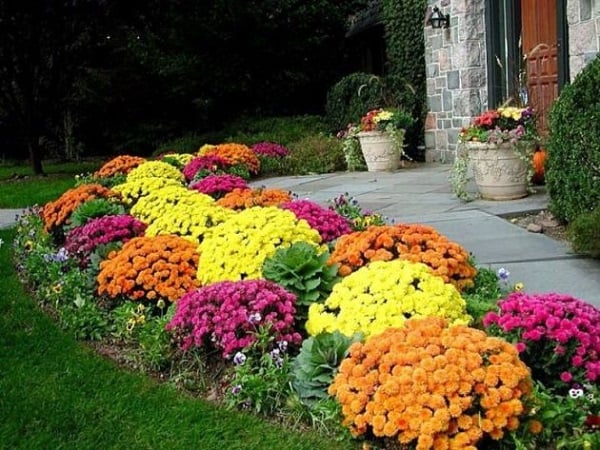

As for the spring transplant, it is needed for mature bushes (without it, the flowers will begin to shrink, and the plant itself will become painful). In addition, it is in the spring that chrysanthemums can be propagated by dividing the bush. They need to be divided every 2-3 years. This procedure rejuvenates the plant, and young chrysanthemums bloom better and winter without problems.
Exact time of work
Young bushes need an annual transplant. If the bush is old, it needs two transplants a year.
In autumn, have time to carry out work from the last weeks of September to the first October. Much depends on the region of your residence and forecasts of weather forecasters. You need to transplant chrysanthemums 4, maximum 3 weeks before the onset of frost.
You will say: but are the bushes just blooming at this time? Not scary, chrysanthemum tolerates transplanting well during flowering.
Important: you should not “play it safe” and transplant the bushes much earlier than the specified time. In this case, the bush will bloom ahead of time, and it will not tolerate frosts well - its flowers and buds, accustomed to the heat, will freeze at the first night cold snap.
Requirements for growing chrysanthemums
What should a novice gardener who wants to grow lush chrysanthemum bushes need to know? You need to know what conditions are necessary for growing flowers.
- For cultivation, you will need to choose an elevated place on the site. It should be sunny, as chrysanthemums are heat-loving plants. If there is not enough light, the shoots will stretch too much, the flowering time will shift, and the plants will become weakened.
- Chrysanthemums are recommended to be grown on neutral or slightly acidic soil. It is necessary to regularly apply a sufficient amount of fertilizer to it, then the flowers will grow better and will delight you with beautiful flowering.
- Complex fertilizers are applied to the flower garden when planting. And if, after planting the plants, you shed the soil with Kornevin's solution, then the plant will develop a powerful root system. The flowers will be strong and beautiful.
- Be sure to cover chrysanthemums for the winter. For this, you can use the covering material Lutrasil. Young chrysanthemums will like it, this material creates an ideal microclimate, warming them and protecting them from hot rays.
Chrysanthemums: mysterious messengers of the East
Chrysanthemum in Greek sounds like "flower-sun", and translated from Latin - "golden flower". Her homeland is the Far East. In Japan and China, the image of this large flower was adorned with symbols of the imperial power: clothes, seals and portraits.
In Korea, graceful palace compositions were created using special low-growing chrysanthemums, called Korean. In Europe, this flower was considered the best decoration of the autumn garden. And over several centuries of growing and breeding chrysanthemums, this opinion has only strengthened!
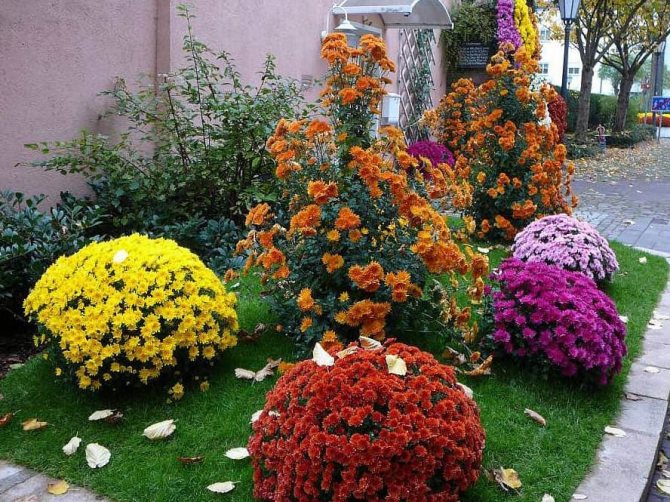

Chrysanthemums are systematized according to several criteria:
- by the method of cultivation (greenhouse, pot, soil);
- by the period of life (annual, perennial);
- by the timing of flowering (early, middle, late);
- by the diameter of the inflorescences (large-flowered, small-flowered);
- frost resistance.
Remember! Frost-resistant varieties include perennial soil Korean chrysanthemums.
Types and common varieties of chrysanthemums
Perennial chrysanthemums are divided into two large groups according to the size of the inflorescences. Each of them includes many different varieties.
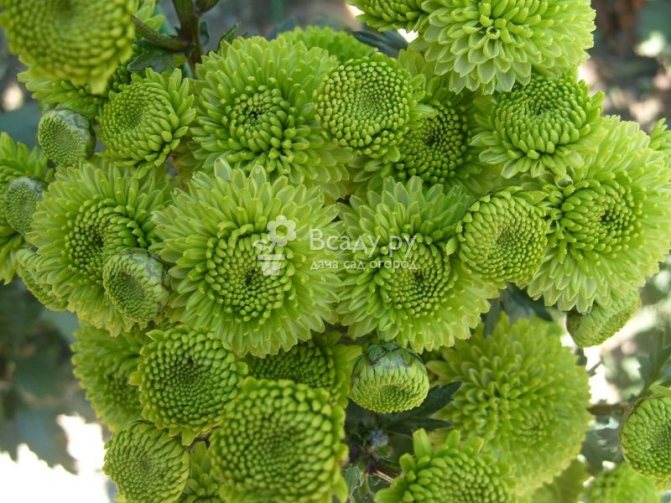

Chrysanthemum Korean Froggy
Small-flowered
These include the Korean chrysanthemum, the planting and care of which are discussed in our material. The size of the flowers varies from 2 to 10 cm, the shape of the leaves resembles that of oak, but much smaller. Flowering begins in early autumn and may continue until frost. Popular varieties of chrysanthemums in the Moscow region: Cheburashka, Talisman, Multiflora.


Chrysanthemum Korean Multiflora
Large-flowered
Tall plants with large single (10-25 cm) flowers, intended for cutting. They do not tolerate a sharp drop in temperature, they often freeze and die in the open field, therefore, in the Moscow region, they are almost never used as garden ones. Common varieties in the southern regions of Russia: Orange ball, Valentina Tereshkova.
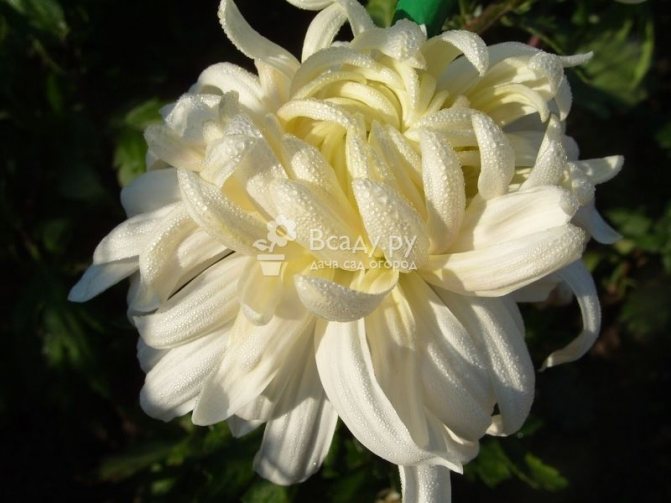

Chrysanthemum large-flowered Valentina Tereshkova
How to care for a room chrysanthemum?
Correct care is the key to the flowering of the bush. It starts from the first days after purchase and continues even after flowering. Sometimes there is an opinion that caring for a room chrysanthemum is difficult and there is no guarantee of flowering for the next season. However, in many ways, the flower growers themselves are to blame, because they are trying to care for the chrysanthemum in the same way as for ordinary green plants on the windowsill.
Soil for indoor chrysanthemum
Land for room chrysanthemum is not something difficult or rare on sale. The soil is perfect for flowering indoor plants, it is universal for all types of chrysanthemums. It is important to feed the plant for good growth and flowering. Indoor chrysanthemum loves chicken droppings as a top dressing, it must be added in dosage, otherwise the soil will be too acidic. For the safety of the plant, the earth is always pierced in the oven. If the task is to get the maximum result, you can mix the ingredients yourself:
- two parts of sod land;
- part of deciduous;
- part of humus;
- part of the sand, but with coarse grains.
Pot for indoor chrysanthemum
You can look after a new flowerpot for your green pet only for the next season:
How to care for a room chrysanthemum after purchase?
After a change of place, any living creature needs time to adapt and get used to it. On the other hand, such plants in stores undergo special processing, and the soil in the pot will be transportable. You can save the flower, for this there are quite simple recommendations, caring for a room chrysanthemum after purchase is as follows:
Indoor chrysanthemum - flowering
We purchase flowering bushes so that the bright colors of the buds decorate the windowsill. However, making a bush bloom is not easy. This is often the result of improper care. It also happens that a room chrysanthemum bush needs help to bloom, home care needs to be corrected:
- the plant will bloom only at temperatures above 18 ° C, the bush does not feel well in extreme heat;
- the flowering period will prolong the correct watering, when it turns out to maintain a balance and prevent the soil from drying out, in the morning and in the evening do not forget about spraying with water;
- it is impossible to fertilize the ground before or after flowering, we feed the indoor chrysanthemum only after the opening of the buds appears - poor soil and little dressing are a frequent reason for the lack of flowering;
- potash and phosphorus fertilizers have a beneficial effect on the appearance of buds;
- if you do not pinch the shoots in time, the bush will stand green and lush, but without buds (it will not work to correct the situation, so you cannot forget about the formation of shoots);
- when the daylight hours are less than seven hours, the plant does not have enough strength to bloom, it is important to provide a sufficient amount of light and heat.
Indoor chrysanthemum - care after flowering
The dormant period is a prerequisite for the further life of any plant. But it is not enough to cut off the faded buds from the shoots, competent wintering will help to prolong the life of the flower. When your indoor chrysanthemum has faded, there are four possible solutions for what to do next:
How to propagate indoor chrysanthemum?
When your chrysanthemum has grown stronger and gave young shoots, it can be propagated. There are several ways how indoor chrysanthemum reproduces:
Transplanting a room chrysanthemum
Young plants need a new pot every season. Adult plants feel quite comfortable in the same flowerpot for two years in a row. Before transplanting an indoor chrysanthemum, you should prepare it. We replace the soil completely, but keep the recipe for its composition. Each subsequent flowerpot should be one and a half liters more, and a couple of centimeters wider. The algorithm of actions is no different from planting young plants: do not forget about the drainage layer, we slightly compact the soil at the roots.
How to prune indoor chrysanthemums?
In addition to pruning after flowering, pruning is used to form a bush. In the question of how to care for indoor chrysanthemums in a pot, this moment is not the last:
- the beginning of pruning for formation falls on the fifteenth day after planting the plant in a pot;
- a piece with several leaves is cut from a stem about 12 cm long;
- then start;
- after another two weeks, new shoots can be found in the sinuses.
How to water indoor chrysanthemum?
One of the difficulties for a gardener is watering a room chrysanthemum. Here you will have to constantly maintain a balance between wet and wet soil. The classic solution with a saucer or a tray of water will not work either, this will lead to rotting of the roots. The varieties that can be grown in a pot were originally garden varieties - we do not neglect spraying, we carry out the procedure only in the morning.
Where and how to plant chrysanthemums in the fall - professional advice
Chrysanthemums are called fall flowers because they bloom at this time of the year. While everything around is turning yellow and falling off, delicate buds continue to delight people. That is why many housewives want to plant chrysanthemums, which can revive their autumn gardens or front gardens. If you are one of them, read our article. From it you will learn a lot of interesting things about chrysanthemums and their cultivation.


Pests
Insects can also damage bushes. There are the following types of chrysanthemum pests:
- aphid. Eats the flower buds and depletes the leaves by sucking the juice out of them. To destroy the insect, use soap with copper sulfate or insecticides (Aktellik, Karate);
- leaf nematode. Yellow or brown spots appear on the leaves of the flower. They gradually fade. If the bush is not promptly treated with an insecticidal preparation, then it will quickly die. In the absence of an opportunity to correct the situation, the plant is dug up along with the roots and destroyed, and healthy bushes are mulched;
- spider mite. Often appears during prolonged standing in hot weather and causes foliage to fall off. Eliminate the pest by spraying the bush with infusion of dope and garlic.
Gardeners are advised to periodically inspect the chrysanthemum for signs of damage so as not to miss the moment when you need to treat it with insecticides.
Diseases of the room chrysanthemum
Frequent fungal diseases include verticillary wilting. This is one of the reasons why the leaves of the room chrysanthemum dry. Of these fungal diseases, one should be afraid and, and septoria, cause no less problems. Among the viral ailments, chrysanthemum is threatened by aspermia, dwarfism, ring spot and mosaic.
Chrysanthemums can be found in almost every flower bed. They deserve love from flower growers due to abundant and long flowering, as well as unpretentious care.
The finished plant can be purchased at a flower shop, or you can grow it yourself using a seedling method or by a way taken from your neighbors. With proper care, young seedlings or cuttings rooted in pots will eventually develop into full-fledged shrubs. And here comes one of the main points - planting a chrysanthemum from a pot into open ground.
In order for the chrysanthemum to quickly take root and delight with its flowering already in the first year, you should pay attention to some points related to the transplant:
- choose the right time and place;
- prepare the soil;
- take care of the bush regularly;
- carry out periodic feeding.

